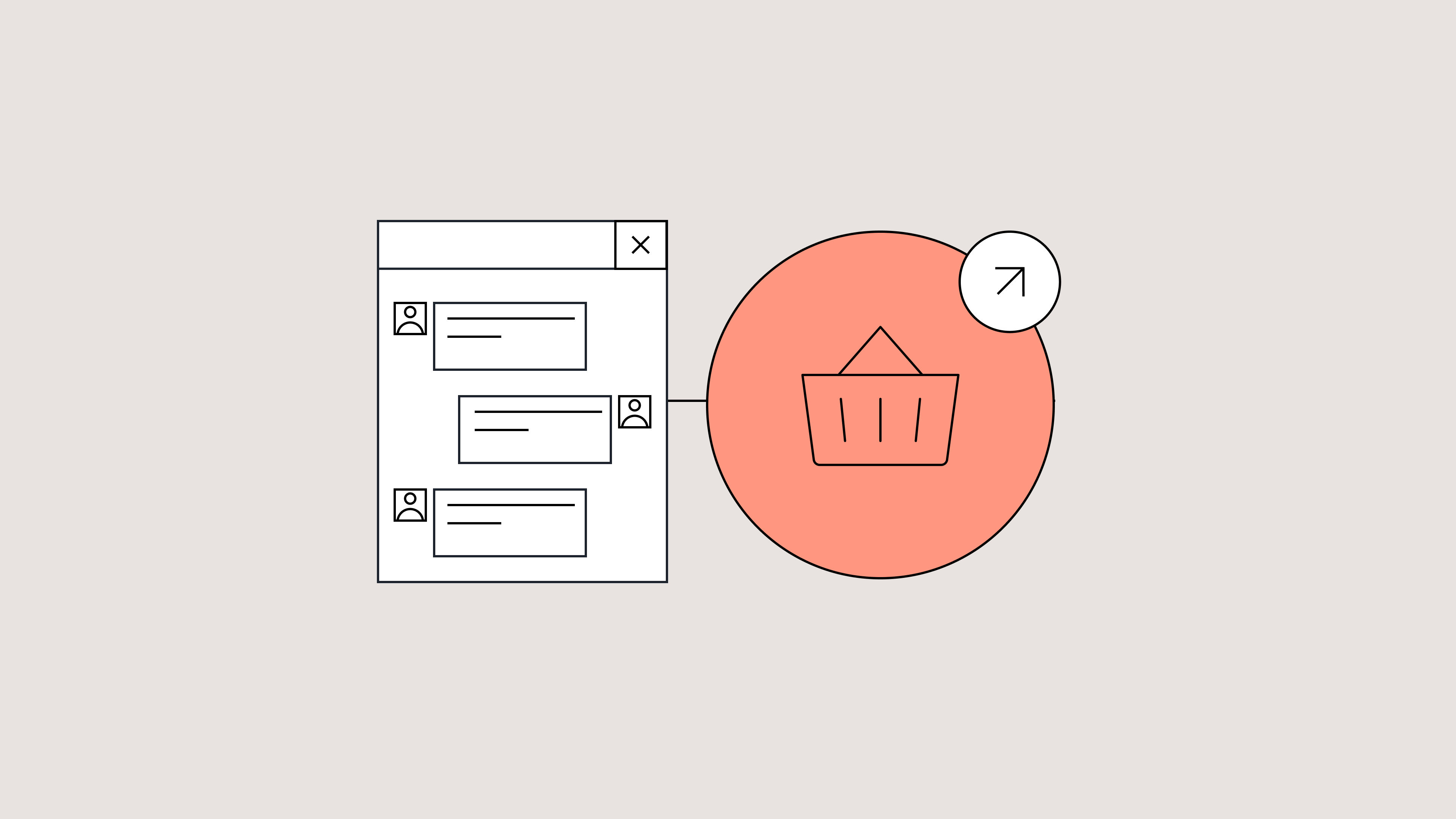


What Happens When CX Agents Love Their Platform? Ask Glossier, Tommy John, and Brunt Workwear
TL;DR:
- Happy agents lead to better CX outcomes. When agents genuinely enjoy using their platform, it boosts productivity, morale, and customer satisfaction.
- Gorgias makes agents’ lives easier. CX teams at Glossier, Tommy John, and Brunt Workwear unanimously preferred Gorgias over legacy systems.
- AI helps teams scale without losing the human touch. By handling basic inquiries, AI gives agents more time for high-impact conversations and personalized support
- Agent satisfaction drives business impact. Brands saw improved team efficiency, reduced operational friction, and revenue gains from more focused, empowered agents.
Everyone talks about how important it is for your ecommerce tools to drive business growth, boost productivity, and deliver a high return on investment. But the equally important (yet often overlooked) third layer is how a tool affects the people using it day-to-day.
The hidden costs of sticking to the CX status quo
The moment CX and ecommerce leaders start noticing slipping KPIs, frustrated agents, or rising support costs, they ask themselves a question, “Is it time to look for something new?” Sticking with the same tool might seem easier — no demos, evaluations, migrations, onboarding, or retraining involved.
But ignoring the shortcomings of your current CX platform can snowball into larger issues over time.
When CX agents don’t like the platform they’re working in daily, bigger problems arise:
- Agent productivity declines
- Morale and employee retention suffer
- Operational costs rise
- Customer experience takes a hit
- Poor data and reporting if agents aren’t using tags or ticket fields correctly
Beyond the thousands of dollars saved in operational costs or hours saved per ticket, Gorgias helps CX agents focus on what they do best — creating the best customer experience possible.
When a platform makes agents’ lives easier, they have more time to focus on the moments that matter, like proactively reaching out to VIPs, sending surprise birthday gifts, or empathetically handling nuanced tickets. Not to mention, they enjoy doing it.
At our annual customer conference, Gorgias Connect, we asked three CX leaders to share their experiences using Gorgias. Aside from the impressive FRTs and CX-generated revenue metrics, one theme stood out — they all mentioned how much their agents enjoyed using Gorgias.
Glossier’s agents have more time to be expert product consultants
Emily Weiss first launched a beauty blog and community, Into the Gloss, in 2010 as a space dedicated to sharing real information, advice, and tips with real people.
This laid the groundwork for Glossier, launching in 2014 with a fresh “skin first, makeup second” philosophy. Amidst the “full glam” era of makeup defined by smoky eyes and bold lips, Glossier’s skincare-oriented approach disrupted the norm.
From the beginning, Glossier has attracted a strong community thanks to its products designed based on community feedback and its social media presence. Today, more than a decade later, the brand has evolved, but its core principles have stayed the same.
As a customer-obsessed beauty brand, it’s no surprise that Glossier takes a thoughtful approach to customer experience.
We sat down with Cati Brunell-Brutman, Head of CX at Glossier, to dive into how the team uses Gorgias to make their lives easier while creating better relationships with customers.
Glossier’s proactive approach to customer experience
How do you approach customer experience at Glossier?
I always like saying customer experience vs. customer service because I think customer service feels like we’re just solving problems in a transactional way. Customer experience is proactive and involves looking at the entire customer journey.
Our team interacts with customers from the moment they first land on the website to when they become repeat users of a product, and eventually, when they become subscribers. There are many opportunities along the way for our team to connect with people, engage in conversations, and make complementary product recommendations.
This was what our founder really wanted this team to be—beauty editors. Everyone on the CX team is an editor (or a product expert), making curated recommendations. My vision for our CX team is to give them more time to lean into that.
Simplifying workflows with AI to empower agents
What are you doing differently now to make sure that your team and your business are more resilient?
My motto for the year is simplify and automate. I don't want anyone on my team to spend their whole day in a Google spreadsheet. So I’m asking questions like, ‘What can I automate? How can I connect tools?’
I really look to my team, especially the newer members, for this, and encourage them to ask, 'Why do we do this?' Because if the answer is because we've always done it that way, that's not a good enough answer for me.
I’m focusing on finding those moments to simplify things so that the team can concentrate on impactful work, such as creating connections and engaging with people. That’s what I really want my team to focus on because it’s what brings value to their work, our customers, and the brand.
How did your team react when you switched to Gorgias from your previous platform?
We actually had our agents weigh in on this. We showed them demos of all the platforms we were considering and had them attend the meetings to speak with the teams.
Then, we ran a poll in Slack and asked the team, ‘If you were making this decision, what platform would you choose?’ All of the agents unanimously voted for Gorgias. So, we’re definitely fans.
How has implementing AI into your CX strategy affected the team?
Throughout the industry, I think people are concerned that there’s going to be a transition to a state where CX is 100% AI, everybody is going to lose their jobs, and customers won’t be able to talk to a person.
But as we've implemented AI at Glossier, we’ve maintained the same team size as when we first started. We just have so much more automation of things like with WISMO tickets, returns, exchanges, and basic tickets that we don’t need a human to answer with macros for six hours straight.
Deeper human-to-human connections powered by better tools
With the additional capacity, what can your team now focus on?
The team is actually able to do more work because they're not dealing with an antiquated technical system, which makes their jobs easier and also saves us money in the long run.
Now, our agents can perform tasks that actually require a human. AI can send out tracking links, and people can do the people work.
We receive a lot of questions about our products, like how to use them or specific recommendations. And that's when we want a person to sit down, look at the customer’s selfie, and do a shade match. Then our editors can ask follow-up questions about what the shopper is looking for and why.
What makes your agents unique, and how does Gorgias help support them?
One of the things that I really love about Glossier is that our editors — our agents — are people, and we have customers who know them by name.
It’s really unique, and they’re almost like internet celebrities within our community. I'll go to our Reddit page and see customers posting screenshots of their conversations with our agents, and other customers will reply saying ‘Oh my gosh, yes!’ or ‘They helped me too!’
Customers will DM us things like ‘This editor recommended a lipstick for me. It was great, I love it. Can that person recommend a blush for me as well?’
Being able to aggregate all those conversations across social media DMs, emails, and chats in one place is invaluable.
Where would your team be without Gorgias?
Having a really bad time in Gmail.
Tommy John found that Gorgias was the perfect fit for its CX team
In 2008, Tom Patterson was a medical salesperson frustrated with ill-fitting undershirts. This problem he faced every day was the catalyst for him to found Tommy John, a dual-gender underwear, loungewear, and apparel company.
Tommy John launched with its flagship product, the Stay-Tucked Undershirt, to solve Tom’s initial struggle that he knew other customers were also facing. Fast-forward a few years, and Tommy John expanded into more categories with innovative underwear product lines
Customer comfort has always been the main priority for Tommy John, embedded in everything from product design to its Best Pair Guarantee. The CX team is responsible for maintaining a customer experience that is just as smooth and seamless as the products they're buying.
Max Wallace, CX Director at Tommy John, shared his experience migrating from a legacy platform to Gorgias and how it impacted his team.
The search for a platform that supported both customers and agents
What motivated you to find a new platform?
We knew we had to seriously explore other options when we were assigned yet another Customer Success Manager on our former platform after having gone through several in a short span. It felt like we were starting from scratch every time, which made it challenging to elevate our CX alongside such a critical partner.
We wanted to do right by our customers and our agents, ensuring they had the reporting and tools they needed, plus more. Gorgias really offered all of those things.
What was most important to you and your team when evaluating helpdesks?
We didn’t want anything that was reinventing the wheel. One platform we looked at wasn’t doing the agents justice by only allowing them to view their own tickets.
We really wanted our agents to have a holistic understanding of the volume we’re receiving, which Gorgias provides. Now they have this fleshed-out understanding of every customer interaction, and that’s been a game-changer. They’ve been loving it.
Gorgias gave agents the tools they needed to thrive
How has Gorgias impacted agent productivity and impact?
We have definitely seen greater speed and productivity. Even something as simple as macro suggestions has helped steer new agents in the right direction. That’s going to be huge during peak seasons, like BFCM.
And the fact that agents can move seamlessly between conversations without losing context means they’re handling more interactions, faster, with less frustration. They feel confident in their workflows, rather than being bogged down in repetitive tasks.
Within two months, using Gorgias’s AI Agent has enabled agents to minimize time-consuming manual tasks and spend more time with high-intent customers, generating over $100,000 in sales.
I’m confident Gorgias will help us achieve our goal of making selling and CX much more integrated. We do want to reward our team for their efforts in driving sales, and we can track conversion rates per agent in Gorgias.
Why was voice integration such a priority for your team?
Before, our agents didn’t have visibility into previous phone calls that other agents had taken. I can't tell you how many times there has been confusion regarding what's going on with the customer because our agents did not have visibility into the customer’s history. We’d have to pull the call recording, pass it along, and by then, the customer would have already been waiting.
So it was essential for us to find a helpdesk that we could use voice with. Now with Gorgias Voice, agents can look back in the timeline, listen to the call, or even read a transcript or AI-generated summary. That’s just been amazing, and they’re loving that.
Tying revenue back to call tickets, where most of our upselling and cross-selling happens, has been another huge win.
Tommy John’s agents unanimously prefer Gorgias
How did agents react after the switch?
The number one thing that validates that we made the right decision is that our agents truly love Gorgias.
Two weeks after going live, we asked, ‘Do you feel you will be more efficient working in Gorgias than our previous platform?’ And it was unanimous — Gorgias, completely. And this was just two weeks in, with everyone still getting their feet wet.
We sent out a survey, and seeing every single person answer in favor of Gorgias told me everything I needed to know about how quickly the team was adapting and how much they preferred the platform.
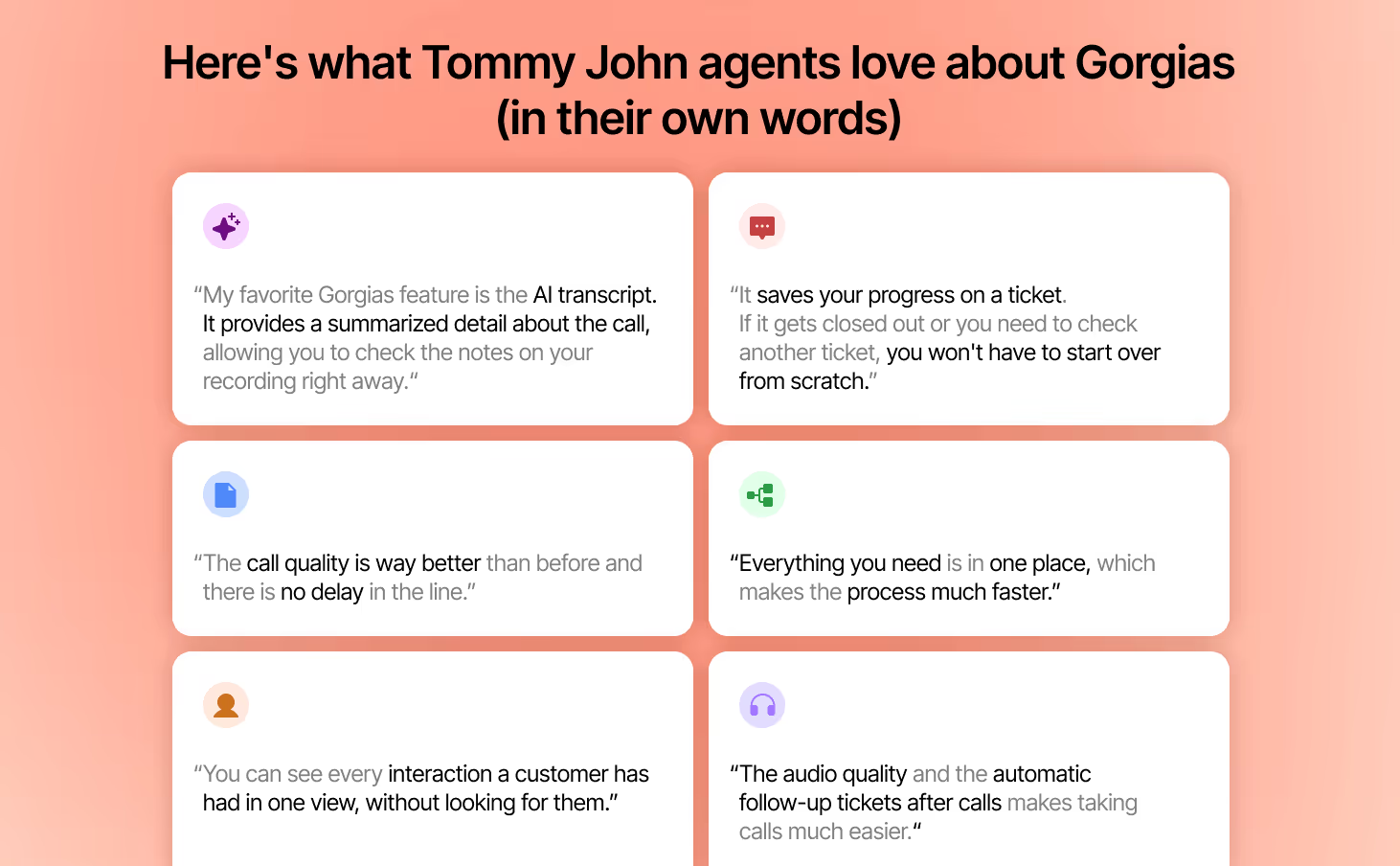
What has been the CX team’s feedback after using Gorgias for a while?
Gorgias has really paid off for our agents in terms of their efficiency. Being able to transition seamlessly from a phone call to a follow-up email with just one click is amazing. And having all of that in the timeline — phone calls, emails, chats — that can’t be beat.
Brunt Workwear’s team stays engaged by helping more customers each day
Eric Girouard founded Brunt Workwear in 2019 to fill a gap in the market for comfortable, high-quality workwear for skilled tradespeople. He came from blue-collar roots himself, and many of his friends and family also work in the trades.
Eric started the company in his garage, focusing on direct-to-consumer sales. Brunt Workwear aims to create products that aren’t just for tradespeople, but are actually built by them.
The workwear brand incorporates a significant amount of customer feedback into the design process to create products that actually make their lives easier. Brunt Workwear’s commitment to its customers is even more evident in its product naming convention — each product is named after a specific tradesworker.
When we spoke with Ruth Trieger, Director of Customer Experience, she shared how the CX team achieves its goal of making solutions as easy as possible for their busy customers — and why agent satisfaction can’t be overlooked.
How Brunt Workwear makes every customer feel at home
How do you think about the state of CX today?
The best retail or CX advice I’ve ever received is to think of everyone who walks into your store or visits your website as someone entering your home. For every visitor, you will do some basic things, such as taking their coat or offering them something to eat or drink. But if you truly want to make someone feel welcome, you’re going to meet them in a way that aligns with their preferences and makes them feel like they’re a part of something.
When you make someone feel welcome, they build an emotional connection with a brand that far transcends any product. That’s a powerful thing.
As I consider customer experience and the growth of AI, I realize there is a constant need to deliver fantastic experiences while using the right amount of resources. If you can do that while still creating a memorable experience, you have a customer for life.
Making life easier for customers and agents with an intuitive platform
What is your goal when designing experiences for Brunt Workwear’s customers?
Our customer is very busy and very hardworking. They have very little spare time. So if or when something goes wrong, I encourage my team to think, ‘How can we make the solution as easy as possible?’ That’s our goal — to put ourselves in their shoes and reduce friction wherever we can.
AI can handle repetitive questions, allowing our agents to jump in quickly when nuance or empathy is needed most. What matters is making sure we are there for customers in the moments that really count.
How does Gorgias help your team achieve these goals compared to previous platforms you’ve worked with?
I come from a customer service training background, and I am used to teams needing weeks to train someone on a platform. With Gorgias, I was able to navigate the system myself in very little time.
As a young but fast-growing brand, we have to be very nimble and change things quickly. Gorgias enables us to do that with a level of ease I've never experienced in my career, so we’re really grateful for the platform.
I love that our agents can interface with the platform in a way that is very easy, which is good for them. From a productivity and metrics standpoint, if they’re moving easily through a platform, I also know that means they’re able to accomplish more touchpoints with our customers — more phone conversations, more emails, more chats. And that means we are helping more people.
How does improved agent satisfaction tie back to business results?
At the end of the day, if you don’t have a happy, high-functioning team, you have literally nothing in all the world. We have a talented team, and the more customers they interact with, the more likely those people are to stay with the brand. So we see an increase in customer lifetime value when our agents can spend more time with our customers.
Gorgias helps agents move from mountains of tickets to meaningful connections
What additional opportunities does AI open up for your team?
AI is not replacing the human touch; it’s giving us more room to lean into it. It reduces friction so that CX agents can take on higher-value work like running close-the-loop programs, proactively reaching out on the phone, and answering faster.
If a customer is asking, ‘Where is my order?’, I don’t need to take up an agent’s time with that because AI can get them a simple, fast answer. Then, when another customer needs somebody’s time, they’re there because that person isn’t answering a mountain of tickets.
That’s the exciting part, AI handles the repetitive stuff, and our agents get to focus on making real connections.
How has Gorgias enabled you to communicate the value of CX to the broader business internally?
The reporting in Gorgias has allowed us to become a true strategic partner in the business. CX sees everything: what’s working, what’s not, and what customers are asking about. For every new product launch, every campaign, and every change, my team is on the front lines. With Gorgias’s reporting, we can bring that insight back to the rest of the organization and help shape smarter decisions.
What’s been cool is that we’re now part of the feedback loop in a much more meaningful way. Without Gorgias, we would not be able to add the same level of value as a strategic partner. That’s where I see our role continuing to shift — becoming more proactive, faster at serving customers, and a critical business function.
At the end of the day, CX knows what’s working, what isn’t, and how customers are feeling. The more we vocalize that, the better off the entire company is.
Choose a CX platform that your CX team actually wants to use
Happy, empowered agents deliver the kind of experiences that keep customers loyal and businesses growing.
Glossier, Tommy John, and Brunt Workwear show what’s possible when teams have a platform designed for them. More efficiency, more impact, and more human connections. Because when agents love their platform, everyone wins.
TL;DR:
- Start by cleaning up your Help Center. Update your articles based on last year’s data, using plain language and clear policy details to boost self-service.
- Use automations to streamline ticket routing and support efficiency. Set rules for tagging, escalation, and inbox views, so your team can respond faster.
- Prep your macros, AI, and staffing plan in advance. Build responses for top FAQs, train AI on the right sources, and forecast agent needs to avoid burnout.
- Automate logistics, upselling, and QA to stay ahead. From showing shipping timelines to flagging low-quality responses, automation ensures smooth operations and more revenue during peak season.
Getting ready for that yearly ticket surge isn’t only about activating every automation feature on your helpdesk, it’s about increasing efficiency across your entire support operations.
This year, we’re giving you one less thing to worry about with our 2025 BFCM automation guide. Whether your team needs a tidier Help Center or better ticket routing rules, we’ve got a checklist for every area of the customer experience brought to you by top industry players, including ShipBob, Loop Returns, TalentPop, and more.
{{lead-magnet-1}}
2025 BFCM automation checklist
- Tidy up your Help Center
- Audit your docs
- Review last year’s BFCM data to find your must-have articles
- Update your policy details
- Edit content using easy-to-understand language
- Expedite your ticket routing automations
- Set up automated ticket tags
- Create an inbox view for each category
- Set escalation rules for urgent tickets
- Set up mandatory Ticket Fields
- Prep your macros and AI agent
- Write macros for your top FAQs
- Train your AI on the right sources
- Define the limits of what AI should handle
- Forecast your BFCM staffing needs
- Use ticket volume to estimate the number of agents
- Plan extra coverage with automation or outsourcing
- Run agent training sessions on BFCM protocols
- Map out your logistics processes
- Negotiate better rates and processing efficiencies
- Automate inventory reorder points
- Build contingency plans for disruptions
- Show shipping timelines on product pages
- Maximize profits with upselling automations
- Guide shoppers with smart recommendations
- Suggest alternatives when items are out of stock
- Engage hesitant shoppers with winback discounts
- Keep support quality high with QA automations
- Automate ticket reviews with AI-powered QA
- Track both agent and AI responses
- Turn QA insights into coaching opportunities
Tidy up your Help Center
Your customer knowledge base, FAQs, or Help Center is a valuable hub of answers for customers’ most asked questions. For those who prefer to self-serve, it’s one of the first resources they visit. To ensure customers get accurate answers, do the following:
- Audit your docs
- Review last year’s BFCM data to find your must-have articles
- Update your policy details
- Edit content using easy-to-understand language
1. Audit your docs
Take stock of what’s currently in your database. Are you still displaying low-engagement or unhelpful articles? Are articles about discontinued products still up? Start by removing outdated content first, and then decide which articles to keep from there.
Related: How to refresh your Help Center: A step-by-step guide
2. Review last year’s BFCM data to find your must-have articles
Are you missing key topics, or don’t have a database yet? Look at last year’s tickets. What were customers’ top concerns? Were customers always asking about returns? Was there an uptick in free shipping questions? If an inquiry repeats itself, it’s a sign to add it to your Help Center.
3. Update your policy details
An influx of customers means more people using your shipping, returns, exchanges, and discount policies. Make sure these have accurate information about eligibility, conditions, and grace periods, so your customers have one reliable source of truth.
Personalization tip: Loop Returns advises adjusting your return policy for different return reasons. With Loop’s Workflows, you can automatically determine which customers and which return reasons should get which return policies.
Read more: Store policies by industry, explained: What to include for every vertical
4. Edit content using easy-to-understand language
Customers want fast answers, so ensure your docs are easy to read and understand. Titles and answers should be clear. Avoid technical jargon and stick to simple sentences that express one idea. To accelerate the process, use AI tools like Grammarly and ChatGPT.
No time to set up a Help Center? Gorgias automatically generates Help Center articles for you based on what people are asking in your inbox.

Expedite your ticket routing automations
Think of ticket routing like running a city. Cars are your tickets (and customers), roads are your inboxes, and traffic lights are your automations and rules. The better you maintain these structures, the better they can run on their own without needing constant repairs from your CX team.
Here’s your ticket routing automation checklist:
- Tag every ticket
- Create views for each category you need (VIP, Returns, Troubleshooting, etc.)
- Set escalation rules for urgent tickets
- Set up mandatory Ticket Fields
1. Set up automated ticket tags
Instead of asking agents to tag every ticket, set rules that apply tags based on keywords, order details, or message type. A good starting point is to tag tickets by order status, returns, refunds, VIP customers, and urgent issues so your team can prioritize quickly.
Luckily, many helpdesks offer AI-powered tags or contact reasons to reduce manual work. For example, Gorgias automatically detects a ticket’s Contact Reason. The system learns from past interactions, tagging your tickets with more accuracy each time.

2. Create an inbox view for each category
Custom or filtered inbox views give your agents a filtered and focused workspace. Start with essential views like VIP customers, returns, and damages, then add specialized views that match how your team works.
If you’re using conversational AI to answer tickets, views become even more powerful. For example, you might track low CSAT tickets to catch where AI responses fall short or high handover rates to identify AI knowledge gaps. The goal is to reduce clutter so agents can focus on delivering support.
3. Set escalation rules for urgent tickets
Don’t get bogged down in minor issues while urgent tickets sit unanswered. Escalation rules make sure urgent cases are pushed to the top of your inbox, so they don’t risk revenue or lead to unhappy customers.
Tickets to escalate to agents or specialized queues:
- Lost packages
- Damaged items
- Defective items
- Failed payments
- Open tickets without a follow-up
4. Set up mandatory Ticket Fields to get data right off the bat
Ticket Fields add structure by requiring your team to capture key data before closing a ticket. For BFCM, make fields like Contact Reason, Resolution, and Return Reason mandatory so you always know why customers reached out and how the issue was resolved.
For CX leads, Ticket Fields removes guesswork. Instead of sifting through tickets one by one, you’ll have clean data to spot trends, report on sales drivers, and train your team.
Pro Tip: Use conditional fields to dig deeper without overwhelming agents. For example, if the contact reason is “Return,” automatically prompt the agent to log the return reason or product defect.
Prep your macros and AI agent
Macros and AI Agent are your frontline during BFCM. When prepped properly, they can clear hundreds of repetitive tickets. The key is to ensure that answers are accurate, up-to-date, and aligned with what you want AI to handle.
- Write macros for your most common FAQs
- Train your AI on the right sources
- Define the limits of what AI should handle
1. Write macros for your top FAQs
Customers will flood your inbox with the same questions: “Where’s my order?” “When will my discount apply?” “What’s your return policy?” Write macros that give short, direct answers up front, include links for details, and use placeholders for personalization.
Bad macro:
- “You can track your order with the tracking link. It should update soon.”
Good macro:
- “Hi {{customer_firstname}}, you can track your order here: {{tracking_link}}. Tracking updates may take up to 24 hours to appear. Here’s our shipping policy: [Help Center link].”
Pro Tip: Customers expect deep discounts this time of year. BPO agency C(x)atalyze recommends automating responses to these inquiries with Gorgias Rules. Include words such as “discount” AND “BFCM”, “holiday”, “Thanksgiving”, “Black Friday”, “Christmas”, etc.
2. Train your AI on the right sources
AI is only as good as the information you feed it. Before BFCM, make sure it’s pulling from:
- Your Help Center with updated FAQs and policies
- Internal docs on return windows, promos, and shipping cutoffs
- Product catalogs with the latest details and stock info
- BFCM-specific resources like discount terms or extended support hours
Double-check a few responses in Test Mode to confirm the AI is pulling the right information.

3. Define the limits of what AI should handle
Edge cases and urgent questions need a human touch, not an automated reply. Keep AI focused on quick requests like order status, shipping timelines, or promo eligibility. Complex issues, like defective products, VIP complaints, and returns, can directly go to your agents.
Pro Tip: In Gorgias AI Agent settings, you can customize how handovers happen on Chat during business hours and after hours.
Forecast your BFCM staffing needs
Too few agents and you prolong wait times and miss sales. Too many and you’ll leave your team burned out. Capacity planning helps you find the balance to handle the BFCM surge.
1. Use ticket volume to estimate the number of agents
Use your ticket-to-order ratio from last year as a baseline, then apply it to this year’s forecast. Compare that number against what your team can realistically handle per shift to see if your current staffing plan holds up.
Read more: How to forecast customer service hiring needs ahead of BFCM
2. Plan extra coverage with automation or outsourcing
You still have options if you don’t have enough agents helping you out. Customer service agency TalentPop recommends starting by identifying where coverage will fall short, whether that’s evenings, weekends, or specific channels. Then decide whether to increase automation and AI use or bring in temporary assistance.
3. Run agent training sessions on BFCM protocols
Before the holiday season, run refreshers on new products, promos, and policy changes so no one hesitates when the tickets roll in. Pair training with cheat sheets or an internal knowledge base, giving your team quick access to the answers they’ll need most often.
Map out your logistics processes
Expect late shipments, low inventory, and more returns than usual during peak season. With the proper logistics automations, you can stay ahead of these issues while reducing pressure on your team.
ShipBob and Loop recommend the following steps:
- Negotiate better rates and processing efficiencies
- Automate your reverse logistics
- Connect your store, 3PL, and WMS
- Automate inventory reorder points
- Show shipping timelines on product pages
1. Negotiate better rates and processing efficiencies
Shipping costs add up fast during peak season. Work with your 3PL or partners like Loop Returns to take advantage of negotiated carrier rates and rate shopping tools that automatically select the most cost-effective option for each order.
2. Automate inventory reorder points
To maintain a steady supply of products, set automatic reorder points at the SKU level so reorders are triggered once inventory dips below a threshold. More lead time means fewer ‘out of stock’ surprises for your customers.
3. Build contingency plans for disruptions
Bad weather, delays, or unexpected demand can disrupt shipping timelines. Create a playbook in advance so your team knows exactly how to respond when things go sideways. At minimum, your plan should cover:
- Weather disruptions - Do you have a backup plan if carriers can’t pick up shipments due to storms or severe conditions?
- Carrier overloads - Which alternative carriers or routes can you switch to if primary partners are at capacity?
- Inventory shortages - How will you handle overselling, low stock alerts, or warehouse imbalances?
- Demand drop-offs - How will you reallocate inventory if BFCM sales don’t match forecasts?
4. Show shipping timelines on product pages
Customers want to know when their order will arrive before they hit checkout. Add estimated delivery dates and 2-day shipping badges directly on product pages. These cues help shoppers make confident decisions and reduce pre-purchase questions about shipping times.
Pro Tip: To keep those timelines accurate, build carrier cutoff dates into your Black Friday logistics workflows with your 3PL or fulfillment team. This allows you to avoid promising delivery windows your carriers can’t meet during peak season.
Maximize profits with upselling automations
You’ve handled the basics, from ticket routing to staffing and logistics. Now it’s time to go beyond survival. Upselling automations create an end-to-end experience that enhances the customer journey, shows them products they’ll love, and makes it easy to buy more with confidence. To put them to work:
- Guide shoppers with smart recommendations
- Suggest alternatives when items are out of stock
- Engage hesitant shoppers with winback discounts
1. Guide shoppers with smart recommendations
BFCM puts pressure on customers to find the right deal fast, but many don’t know what they’re looking for. Make it easier for them with macros that point shoppers to bestsellers or curated bundles. For a more advanced option, conversational AI like Gorgias Shopping Assistant can guide browsers on their own, even when your agents are offline.
2. Suggest alternatives when items are out of stock
No need to damage your conversion rate just because customers missed the items they wanted. Automations can recommend similar or complementary products, keeping customers engaged rather than leaving them empty-handed.
If an item is sold out, set up automations to:
- Suggest similar items like another size, color, or variation of the same product.
- Highlight premium upgrades such as a newer model or higher-value version that’s in stock.
- Cross-sell and offer bundles to keep the order valuable even without the original item.
- Notify customers about restocks by letting shoppers sign up for back-in-stock alerts.
3. Engage hesitant customers with winback discounts
Automations can detect hesitation through signals like abandoned carts, long checkout times, or even customer messages that mention keywords such as “too expensive” or “I’ll think about it.” In these cases, trigger a small discount to encourage the purchase.
You can take this a step further with conversational AI like Gorgias Shopping Assistant, which detects intent in real time. If a shopper seems uncertain, it can proactively offer a discount code based on the level of their buying intent.
Keep support quality high with QA automations
During BFCM, speed alone is not enough. Customers expect accurate, helpful, and on-brand responses, even when volume is at its highest. QA automations help you prioritize quality by reviewing every interaction automatically and flagging where standards are slipping. To make QA part of your automation prep:
- Automate ticket reviews with AI-powered QA
- Track both agent and AI responses
- Turn QA insights into coaching opportunities
1. Automate ticket reviews with AI-powered QA
Manual QA can only spot-check a small sample of tickets, which means most interactions go unreviewed. AI QA reviews every ticket automatically and delivers feedback instantly. This ensures consistent quality, even when your team is flooded with requests.
Compared to manual QA, AI QA offers:
- Full coverage: Every ticket is reviewed, not just a sample.
- Instant feedback: Agents get insights right after closing tickets.
- Consistency: Reviews are unbiased and use the same criteria across all interactions.
- Scalability: Works at any ticket volume without slowing down your team.
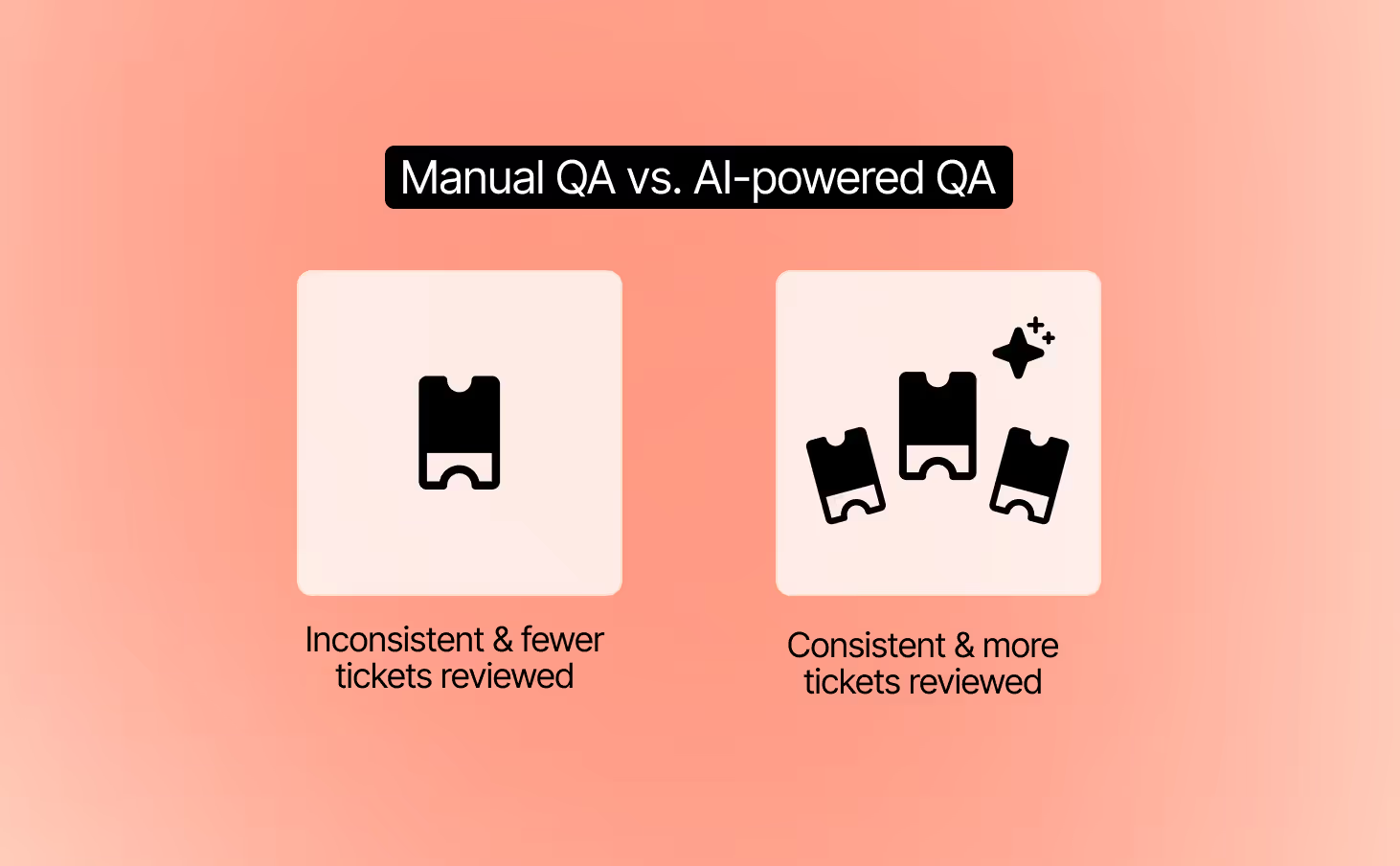
2. Track both agent and AI responses
Customers should get the same level of quality no matter who replies. AI QA evaluates both human and AI conversations using the same criteria. This creates a fair standard and gives you confidence that every interaction meets your brand’s bar for quality.
3. Turn QA insights into coaching opportunities
QA automation is not just about grading tickets. It highlights recurring issues, unclear workflows, or policy confusion. Use these insights to guide targeted coaching sessions and refine AI guidance so both humans and AI deliver better results.
Pro Tip: Pilot your AI QA tool with a small group of agents before peak season. This lets you validate feedback quality and scale with confidence when BFCM volume hits.
Give your ecommerce strategy a boost this holiday shopping season
The name of the game this Black Friday-Cyber Monday isn’t just to get a ton of online sales, it’s to set up your site for a successful holiday shopping season.
If you want to move the meter, focus on setting up strong BFCM automation flows now.
Gorgias is designed with ecommerce merchants in mind. Find out how Gorgias’s time-saving CX platform can help you create BFCM success. Book a demo today.
{{lead-magnet-2}}
Newsletter Signup
The best in CX and ecommerce, right to your inbox
Featured articles

13 Best Live Chat Apps for Shopify in 2025
TL;DR:
- The best Shopify live chat apps combine AI automation with human support so you can instantly handle common questions and escalate complex issues to a real person.
- Try out apps with free trials before you commit, like Gorgias (7-day trial), Tawk.to (free), and MooseDesk (free plan).
- Look for key features like automation, helpdesk integration, and chat-to-human handoff to ensure your live chat can scale with your support and sales goals.
- Roll out chat gradually instead of enabling it everywhere at once. Start with high-intent pages, add automation, and route questions to the right team to keep things manageable.
Thanks to conversational AI, live chat has become a larger shift toward always-on support for Shopify stores. It improves customer experience, helps drive sales, and boosts retention—all while giving shoppers a faster, more personal way to connect with your brand.
In fact, 82% of online shoppers say they’d talk to a chatbot if it meant avoiding a wait. The challenge? Choosing the right live chat app. With over 1,000 options in the Shopify App Store, the search can feel overwhelming.
That’s why we’ve rounded up the 13 best Shopify live chat apps to help you narrow it down.
(Not on Shopify? Explore our best live chat apps for ecommerce or best live chat apps overall instead.)
{{lead-magnet-1}}
Live chat vs. conversational AI—what’s the difference?
Live chat is a way for shoppers to get real-time support from a human agent. The best live chat apps also use automation to handle FAQs, route conversations, or collect details before handing things off to your team.
Conversational AI, on the other hand, goes a step further. Instead of assisting your agents, AI chatbots can carry out entire conversations on their own. They answer questions, recommend products, and resolve issues without human involvement.
Today’s top Shopify live chat tools bring these two worlds together. You get the flexibility of human-led support when it matters most, plus AI agents that scale your availability and keep response times low.
Best live chat apps for Shopify in 2025
- Gorgias
- Zendesk
- tawk.to Live Chat
- O: WhatsApp Chat, Contact Form
- Chatra Live Chat
- Re:amaze Live Chat
- Tidio
- LiveChat
- Shopify Inbox
- Formilla Live Chat
- eDesk Live Chat
- Jotform AI Chatbot & Live Chat
- Moose: AI Chatbot & Live Chat
App |
Pricing |
Helpdesk Integration |
Automation and AI |
Handoffs to Humans |
Ease of Setup |
Language Localization |
|---|---|---|---|---|---|---|
Gorgias |
$10/mo (7-day trial) |
✅ Native helpdesk |
Rules, macros, AI Agent, Shopping Assistant |
✅ Smooth routing to agents |
Easy, no coding |
✅ |
Zendesk Chat |
$49/agent/mo (14-day trial) |
✅ Zendesk Support Suite |
Macros, triggers, chatbots in higher tiers |
✅ Handoffs supported |
Steeper learning curve |
✅ |
Tawk.to |
Free (branding removal extra) |
❌ |
Basic auto-responses, no advanced AI |
✅ Transfer supported |
Easy, no coding |
✅ |
O: WhatsApp Chat, Contact Form |
Free plan + paid tiers (from $2.99/mo) |
❌ No native helpdesk |
Basic automation & preset welcome messages |
✅ Via your linked messaging apps |
Easy, one-click install & widget setup |
✅ |
Chatra |
$31/mo (free plan available) |
❌ |
Typo correction, chatbots (not advanced AI) |
✅ Manual transfer |
Easy, no coding |
✅ |
Re:amaze |
$29/mo (14-day trial) |
✅ Full helpdesk |
Chatbots, rules, macros, workflows |
✅ Integrated with helpdesk |
Easy, no coding |
✅ |
Tidio |
$29/mo (free plan available) |
❌ |
Automation flows, AI chatbot templates |
✅ Transfers to agents |
Easy, no coding |
✅ |
LiveChat |
$16/mo (14-day trial) |
✅ via LiveChat + integrations; not Shopify-native helpdesk |
Chatbots (via add-ons) |
✅ Handoffs supported |
Easy, no coding |
✅ |
Shopify Inbox |
Free |
❌ Limited to Shopify Inbox/Ping |
No advanced AI, basic chat only |
✅ Manual transfer |
Requires Ping app install |
❌ |
Formilla |
$17.49/mo (15-day trial) |
❌ |
Basic automation rules, no advanced AI |
✅ Manual transfer |
Easy, app install |
❌ |
eDesk Live Chat |
$69/agent/mo (14-day trial) |
✅ eDesk helpdesk |
Limited automation, no advanced AI |
✅ Manual transfer |
Easy, app install |
❌ |
Jotform AI Chatbot & Live Chat |
Free (100 convos); Paid $39/mo |
❌ |
AI chatbot trained on store data, integrations with Slack/WhatsApp |
✅ Smooth transitions |
Easy, no coding |
✅ |
Moose (MooseDesk) |
Free plan; Paid tiers available |
✅ Unified helpdesk inbox |
AI chatbot, FAQ builder, auto-translate |
✅ Integrated handoffs |
Easy (PWA, no coding) |
✅ |
1. Gorgias
Gorgias is the best customer experience platform for ecommerce merchants. It provides you with all the features you need to create an incredible customer support experience, improve team performance, and increase sales.
One of Gorgias’s most noticeable features is its tight integration with ecommerce platforms, including Shopify, Magento, and BigCommerce. Hence, Gorgias can pull relevant data like order tracking numbers, last order details, loyalty points, etc., from your Shopify dashboard right to your helpdesk.
Another exciting feature of Gorgias chat is Shopping Assistant, a conversational AI tool that helps support teams increase sales on their website. Using your Shopify catalog, AI can recommend, upsell, and offer tailored discounts at scale so every chat conversation is maximized.
Standout features:
- Compatible with Shopify and Shopify Plus brands
- Affordable pricing plans
- Offers a conversational AI tool that supports and sells
- Fantastic customer support team
Why it may not be for you:
- No free plan
Pricing: Basic plans start at $10/mo. A 7-day free trial is available.
2. Zendesk
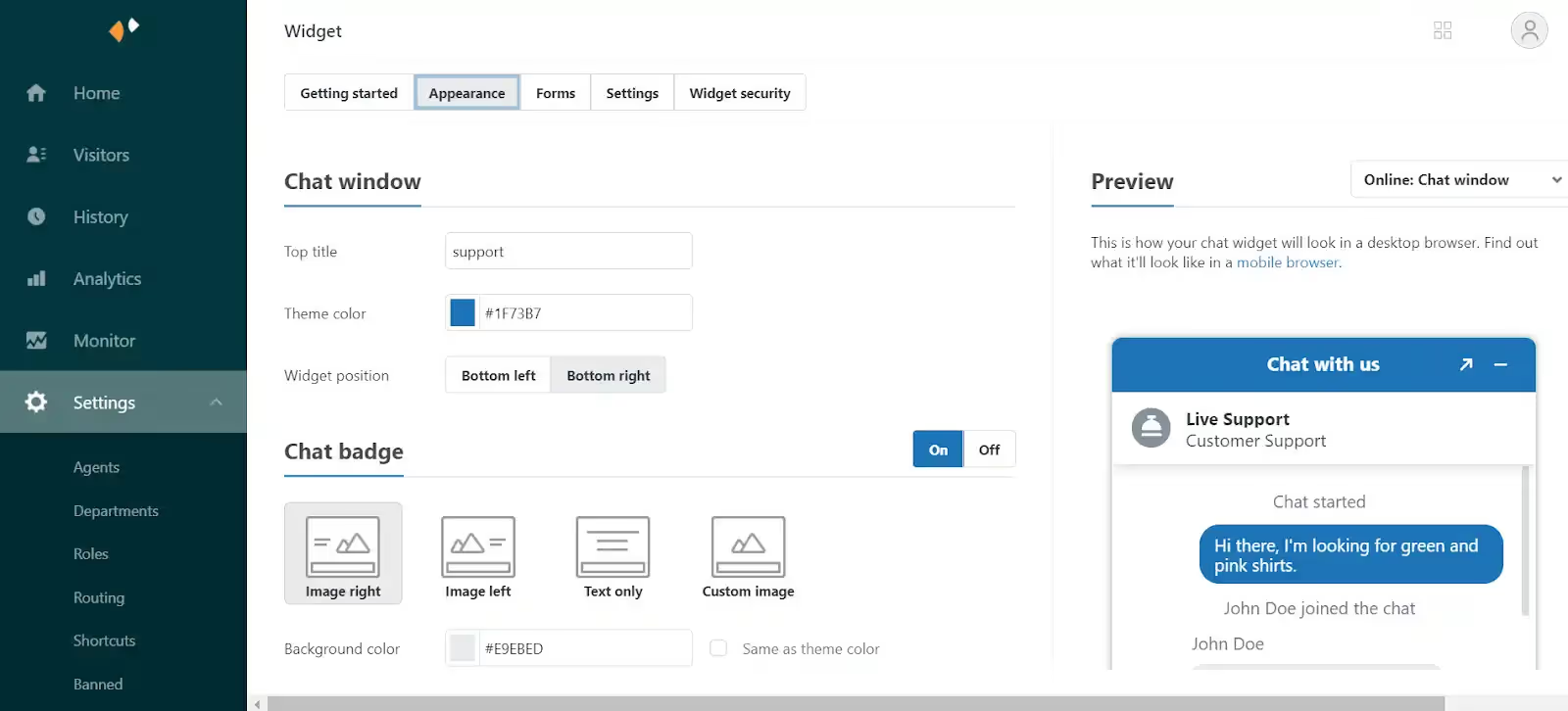
Developed by Zendesk, Zendesk Chat is a live chat app for Shopify stores. It allows you to communicate with customers over your Shopify storefront, mobile apps, and popular messaging apps like Facebook Messenger, Twitter, and Line.
If you’re a Zendesk customer using the Team plan or above, you can use Zendesk Chat for free.
Standout features:
- It’s a good choice if you're using Zendesk Support Suite
- Supports all essential features of a typical live chat app
- Gather customer feedback via chat ratings
- Share files like screenshots, product guides, or GIFs with customers
Why it may not be for you:
- Non-user-friendly interface and steep learning curve for beginners
- Expensive pricing plans for Shopify store owners
- A lot of technical errors when installing and using the app
- Bad customer support team
- Not suitable for ecommerce businesses
Pricing: Starting from $49 per agent per month. A 14-day free trial is available.
3. tawk.to Live Chat
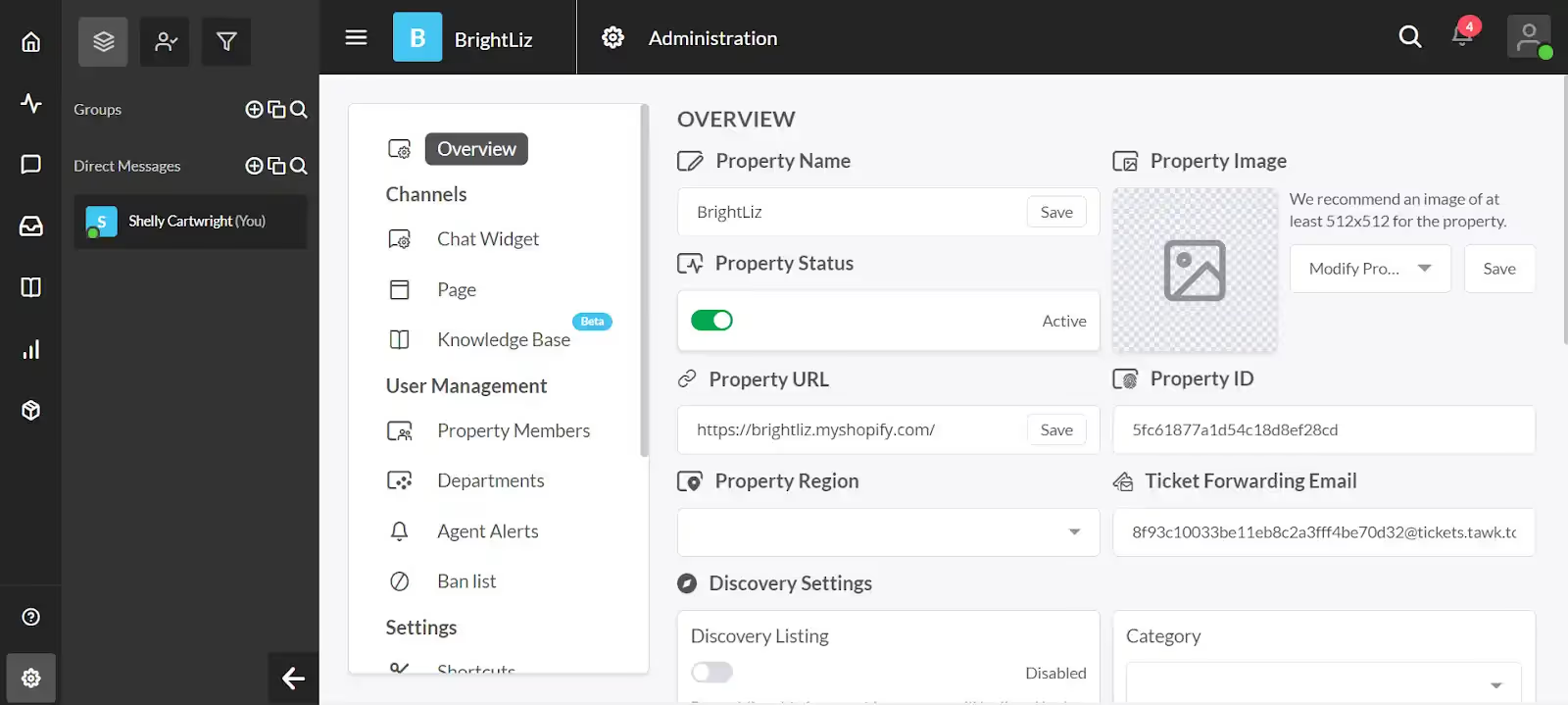
Tawk.to Live Chat is an agent-centric chat application for Shopify stores. The best thing about this app is it’s 100% free—there’s no limit to the number of agents, chat volumes, or sites you can add widgets to.
Standout features:
- Supports 27 languages
- Easy to set up, free forever, and secure
- Available on PC, macOS, iOS, and Android
Why it may not be for you:
- Many features are not user-friendly
- Need to pay a small fee to remove the “Powered by Tawk.to” branding
- The customer support team isn’t always responsive
Pricing: Free
4. O: WhatsApp Chat, Contact Form

O: WhatsApp Chat, Contact Form makes it easy for shoppers to reach you through the channels they already use, like WhatsApp, Facebook Messenger, Telegram, and Instagram. Instead of building out a complex live chat system, it focuses on providing a simple, customizable widget that connects directly to your preferred messaging platforms.
Standout features:
- Integrates with 20+ messaging channels
- Customizable chat button and widget design
- Contact form option for capturing customer details when agents aren’t available
- Targeting rules to show/hide the widget on specific pages or devices
Why it may not be for you:
- Doesn’t offer advanced automation or AI-powered chat
- Lacks ticket management and deep helpdesk integrations
Pricing:
- Free plan available. Paid plans start at $2.99/month
5. Chatra Live Chat
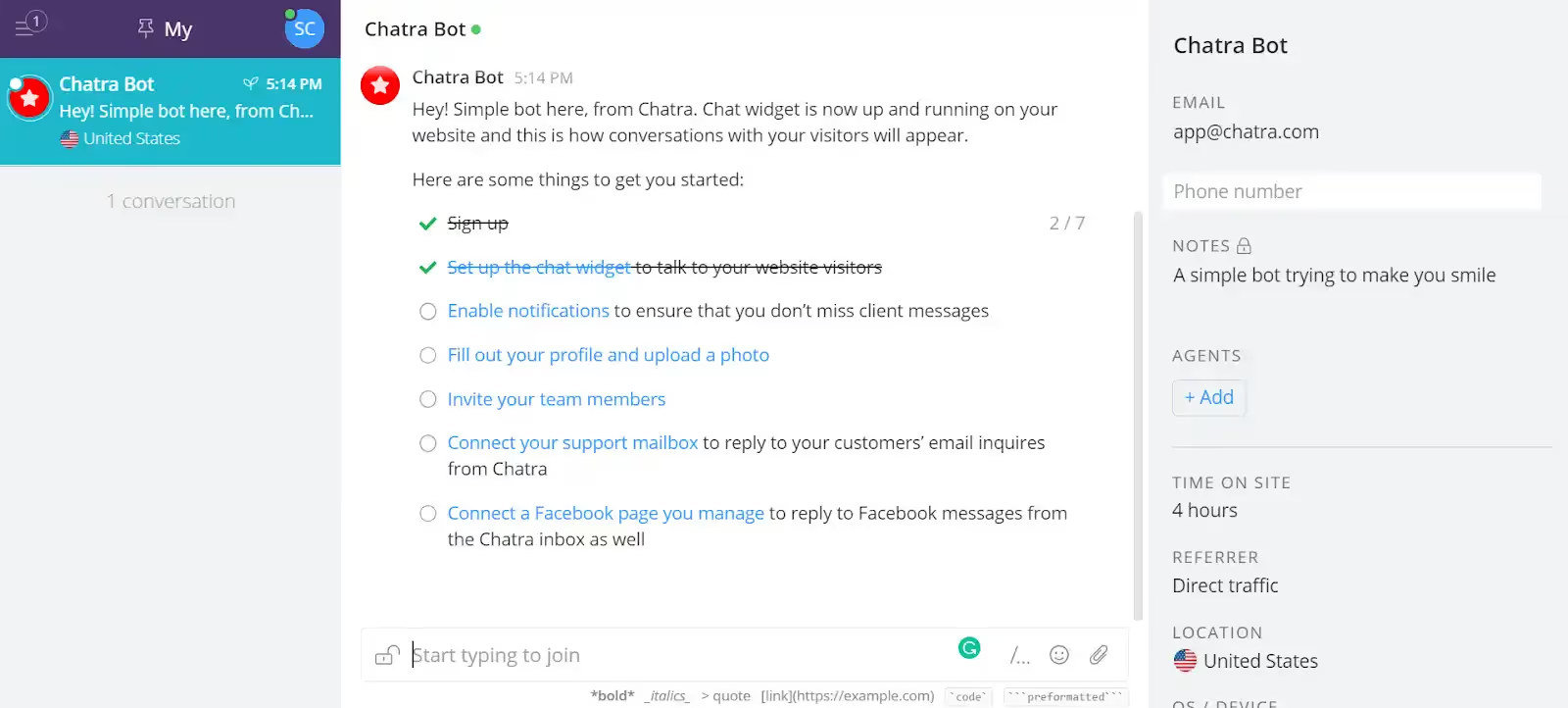
Chatra Live Chat claims to help you “sell more, answer questions, and alleviate concerns to help visitors place an order.” It also allows you to view a shopper's cart contents in real-time to identify the most valuable customers and provide tailored assistance.
Standout features:
- Support a free forever plan
- Provide useful live chat features like typo correction and group chats
Why it may not be for you:
- Most advanced features aren’t available in the free plan
- Lack of customization options
Pricing: Starting from $31 per month. A free plan is available.
6. Re:amaze Live Chat

Re:amaze is a helpdesk, live chat, ticketing, chatbot, and FAQ for small, medium, and enterprise businesses. It allows you to handle support tickets across channels, including emails, live chat, Facebook pages, Messenger, Twitter, Instagram, SMS, VOIP, and WhatsApp.
Reamaze Live Chat aims to help you support customers faster by chatting with them in real-time. It offers many features that are similar to Gorgias’ and other live chat apps.
Standout features:
- Multi-store support
- Can send products to customers in chat
- Flexible pricing, no contract
Why it may not be for you:
- User interface is a bit outdated and not user-friendly
- Macros and rules need improvement
Pricing: Starting from $29 per month. A 14-day free trial is available.
7. Tidio

With approximately 900 reviews, Tidio Live Chat is currently the highest-rated live chat app on the Shopify App Store. Tidio merges live chat, bots, and marketing automation to provide you with a comprehensive live chat app.
Standout features:
- Rich widget customization options
- Many automation and bot templates
- Multiple languages supported
Why it may not be for you:
- Shallow integration with Shopify and other ecommerce platforms
- Pricing plans are a bit high for Shopify merchants
Pricing: Starting from $29 a month. A free plan is available.
8. LiveChat

LiveChat is a messaging app that offers many unique features for its live chat service. It can integrate with most customer relationship management (CRM) tools like Zendesk and ecommerce platforms like Shopify.
Standout features:
- Chat window loads instantly and is easy to use
- Clean and well-designed user interface
Why it may not be for you:
- Not optimized for Shopify since LiveChat is also a CRM
Pricing: Starting from $16 per month. A 14-day free trial is available.
9. Shopify Inbox

Shopify Inbox is Shopify’s native live chat function that allows you to have real-time conversations with customers visiting your Shopify store. It’s an extension to the messaging capabilities already available within Shopify Ping.
Note that all your chats are managed in Shopify Ping. Shopify also asks your customers to provide a phone number or email address in order to start a chat with you. Their information will be added to your Customer list in Shopify or matched to an existing customer.
Standout features:
- Clean and intuitive interface
- Free forever
Why it may not be for you:
- A bit complicated for beginners to install the app
- To use Shopify Chat, you must use Shopify Ping on your desktop (shopifyping.com) or install it on an iOS, iPad, or Android device to receive and respond to messages.
Pricing: Free
10. Formilla Live Chat

Formilla Live Chat offers free live chat and premium services for your Shopify store. You can use this app to chat with your visitors live if they have any questions or need support from your store.
Standout features:
- Easy and simple to use
- Connects with customers quickly
Why it may not be for you:
- Many features locked behind higher plans
- Lack of rules and automation
Pricing: Starting from $17.49 per month. A 15-day free trial is available.
11. eDesk Live Chat
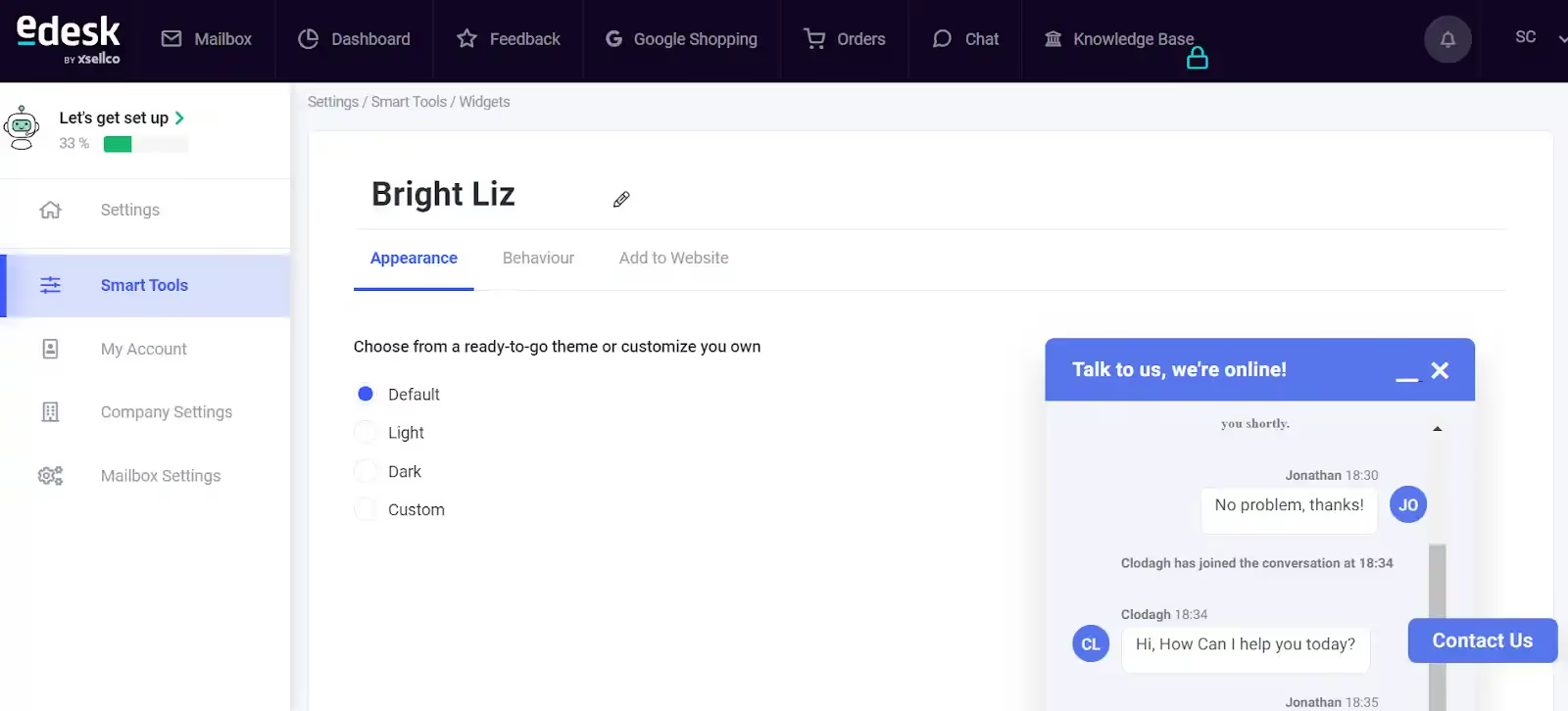
eDesk is a comprehensive customer helpdesk designed for ecommerce. It helps you create a positive experience for customers across your marketing channels: email, live chat, social media, and online store.
Standout features:
- Clean and intuitive user interface
- Good customer service team
Why it may not be for you:
- Pricing plans are steep for Shopify merchants
- Not optimized for ecommerce
- Lack of essential live chat features
Pricing: Starting from $49 per month. A 14-day free trial is available.
12. Jotform AI Chatbot & Live Chat
Jotform AI Chatbot & Live Chat lets you provide 24/7 support with an AI-powered chatbot that integrates directly into your Shopify store. The app automatically trains on your store’s data to answer FAQs, track orders, and even recommend products, while still allowing live chat when a human touch is needed.
Standout features:
- AI trained on your store’s data
- Multi-language support (English, German, French, Spanish, and more)
- Integrations with WhatsApp, Messenger, Slack, and Google Drive
Why it may not be for you:
- Advanced features only available on paid tiers
- More complex than simple live chat apps
Pricing: Free plan available (includes up to 100 monthly conversations). Paid plans start at $39/month with higher limits.
13. Moose: AI Chatbot & Live Chat
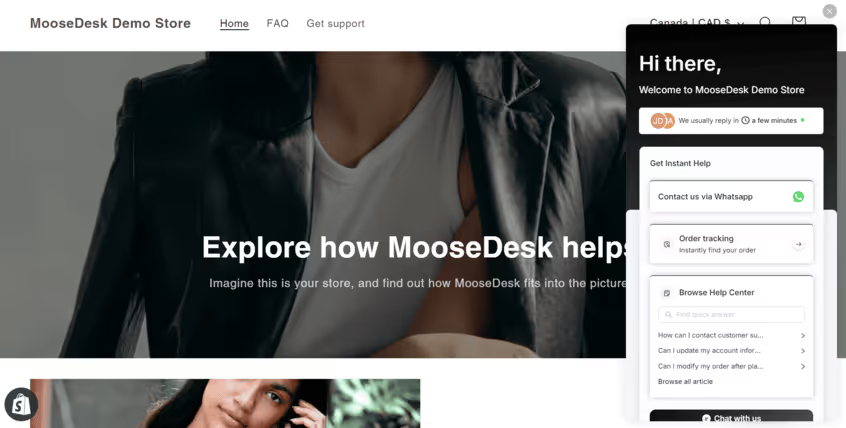
Moose: AI Chatbot & Live Chat (MooseDesk) brings live chat, helpdesk, and omnichannel messaging into one unified tool built for Shopify. With AI-powered automation and support across chat, email, WhatsApp, and social, it's engineered to help you respond faster — without leaving your dashboard.
Standout features:
- Trained on your store data (FAQs, products, etc.)
- Central inbox for live chat, email, WhatsApp, Messenger, Instagram, and more
- Multilingual support and built-in FAQ/self-service features
Why it may not be for you:
- Because it’s a newer tool, some merchants report quirks or missing native mobile app (it's built as a Progressive Web App currently)
- Push notification behavior and instant alerts can vary depending on device settings
Pricing: Free
How to roll out live chat without slowing down support
The benefits of live chat are real, but only if you roll it out with a plan. Too often, brands turn it on everywhere and suddenly face a flood of new tickets their team can’t keep up with. The result is often longer wait times and frustrated customers.
The key is to treat live chat as both a support and sales channel. That means leaning on automation to handle the quick, repetitive stuff, and reserving agent time for higher-value conversations.
Here’s how to strike the right balance:
- Start with automation: Use chatbots to answer FAQs, collect order details, or qualify sales leads before passing them to a human.
- Set smart routing rules: Direct pre-sales questions to your sales team, and post-purchase issues to support, so customers reach the right person faster.
- Limit availability at first: Roll out chat during peak hours or on high-intent pages (like product or checkout) to control volume.
- Layer in human support: Keep agents available for complex or high-stakes conversations where personal service matters most.
By combining humans with automation, you’ll give customers the instant responses they expect, without creating another backlog for your team.
Turn conversations into conversions with the right app
There’s no single Shopify live chat app that works for every store. Each brand has its own support needs, sales goals, and team workflows—which means the “best” tool depends on what you’re trying to achieve.
The smartest approach is to test a couple of the apps above and see which one fits your business best. The right live chat tool should do three things: improve customer satisfaction, make your team’s job easier, and contribute to your bottom line.
And if you’re looking for a solution built specifically for ecommerce? Book a demo with Gorgias as the best Shopify-native option.
{{lead-magnet-2}}

The Updated Gorgias Helpdesk: Built for the Moments that Matter
TL;DR:
- Get instant context with Ticket Summaries. Jump into any conversation without digging through past messages or tabs.
- Organize tickets and customers with Ticket and Customer Fields. Attach properties to tickets and customers to see the whole picture, then turn it into reportable data.
- Support global customers with real-time translations. Engage in natural conversations in your customer’s language without paying for another tool.
- Resolve urgent issues with Priority Scoring. Rank tickets by importance, so high-value or sensitive issues don’t get overlooked.
- Onboard quickly with in-house migration. Whether you’re coming from Zendesk or Richpanel, Gorgias handles the move for you.
We recently unveiled the latest upgrades to Gorgias Helpdesk during Moments that Matter: Meet the Modern Helpdesk.
The event was hosted by Bora Shehu, VP of Product Design, with updates from John Merse (VP of Product), Fraser Bruce (Senior Solutions Consultant), Nicole Simmen (Senior Manager, Customer Implementation), and a customer story from Michael Duran (Operations Manager, Authentic Brands).
From quality of life improvements to brand new features, here’s what’s waiting for you in Gorgias.
Watch the full presentation here:
Support faster with built-in ticket summaries
Agents shouldn’t have to dig for context. Every conversation now comes with Ticket Summaries. Whether an agent has jumped into a ticket mid-conversation or is dealing with a new customer, these AI-generated summaries tell the whole story in no time.
We’ve also given the Customer Timeline a makeover. Now, you can glance at past tickets and order updates in one clean view. Plus, a dedicated Order View lets agents dive into past purchases without leaving the ticket or opening a new tab.
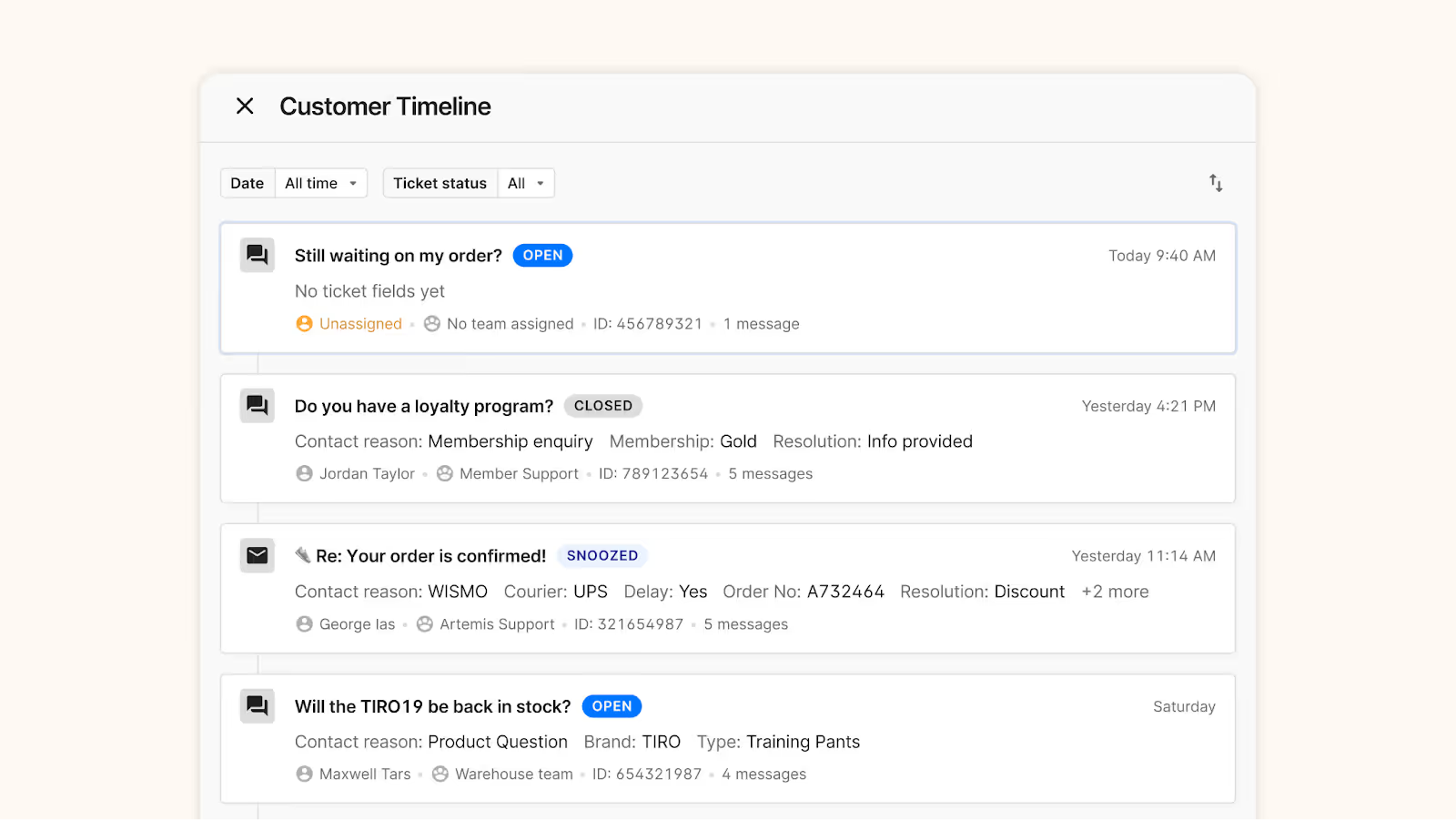
Enrich your data with detailed ticket and customer properties
Agents have always had visibility into customer history, but now that context is easier to act on.
Ticket Fields automatically tags tickets with AI-detected reasons, whether that’s shipping questions or product feedback, to help organize your conversations more effectively.
Then, add in another layer of data using Customer Fields (in beta) to note whether you’re speaking to a longtime, VIP customer or a customer with a history of high returns.
All of this data can be funneled into your ticket reports, making it easier for your team to discover new insights about your products, support quality, and more.

Speak every customer’s language with instant translations
Taking your brand global doesn’t have to mean hiring a whole new team or spending extra on a localization tool. AI-powered translations (in beta) will soon be available on the helpdesk.
Finally, your team will be able to support customers in any language in real-time. Customers write in their native language, agents respond in theirs, and the exchange feels natural on both sides.

Never miss urgent tickets with Priority Scoring
How many times has an urgent ticket been buried at the bottom of your inbox? The new Priority Scoring system prevents that by automatically labeling tickets as Low, Normal, High, or Critical based on your Rules.
For example, you might label a negative Facebook comment with threatening sentiment as ‘High,’ or bump high-value shoppers to the top with a ‘Critical’ label. This ensures your team always sees the conversations that need the most attention, so no sensitive issue slips through the cracks.
Shape every call journey with the new IVR flow builder
Now in beta, our flow-based IVR (interactive voice response) system lets teams on Gorgias Voice build customized call journeys for every type of conversation. Route customers through interactive menus, segment them based on their data, or direct them to voicemail, and schedule SMS follow-ups and callbacks.
To match agent availability, you can set business hours per phone number and per channel across storefronts. Teams also have more flexibility with ring strategies (ring available agents all at once or one at a time), wrap-up time between calls, and faster availability refreshes.
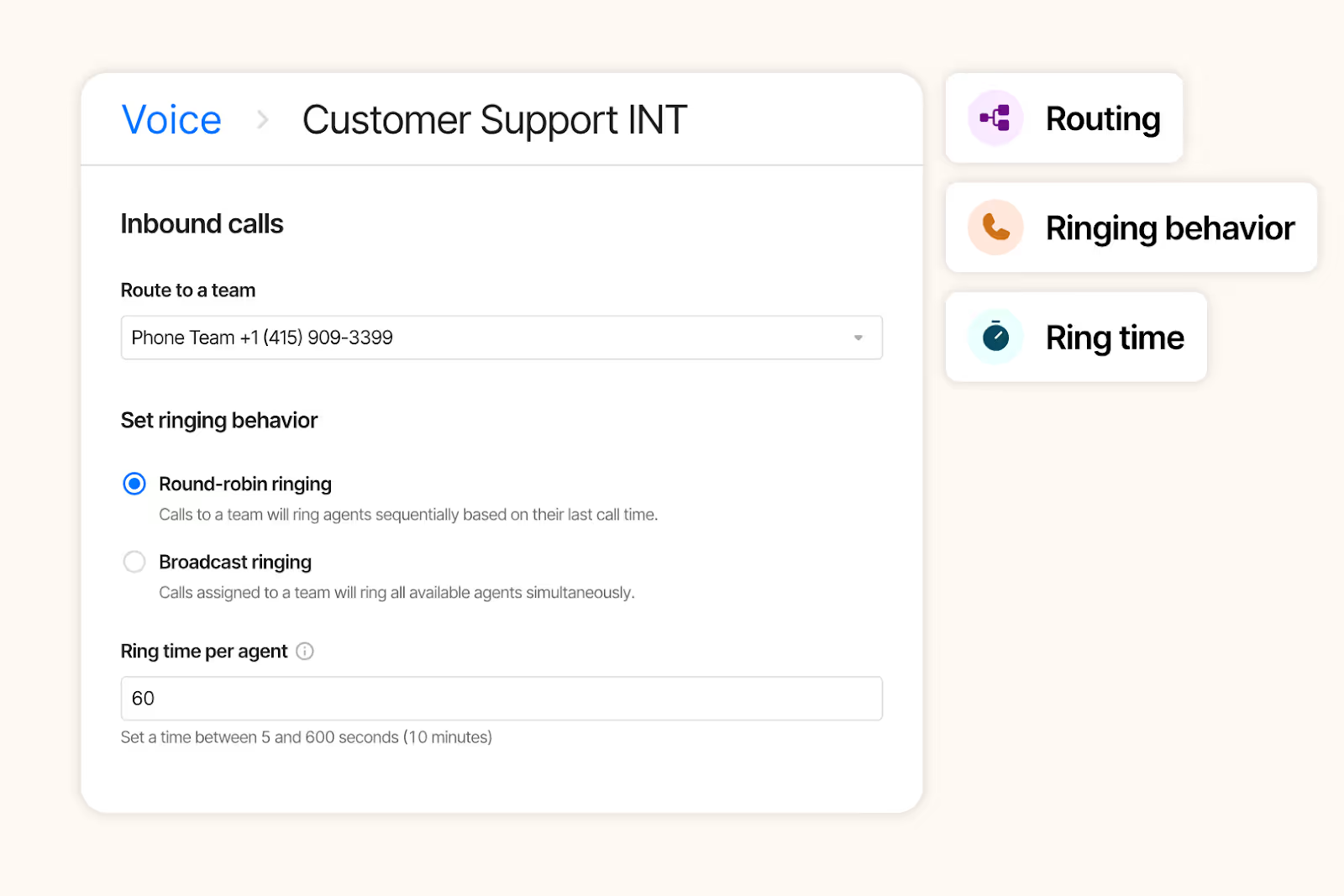
Stay on top of every goal with custom dashboards
We understand that CX teams need more than surface-level KPIs—they need to know what’s actually driving performance, revenue, and retention.
With Dashboards, you can build reports focused on CX data you care about, from agent performance to product return trends. Then, filter by store or sub-brand to zoom in on the details each team is responsible for.
We’re also introducing the Human Response Time metric to show how quickly your team responds to escalations from AI Agent. This gives you a clear sign of what issues require human attention, how fast they’re resolved, and whether you need to adjust staffing.
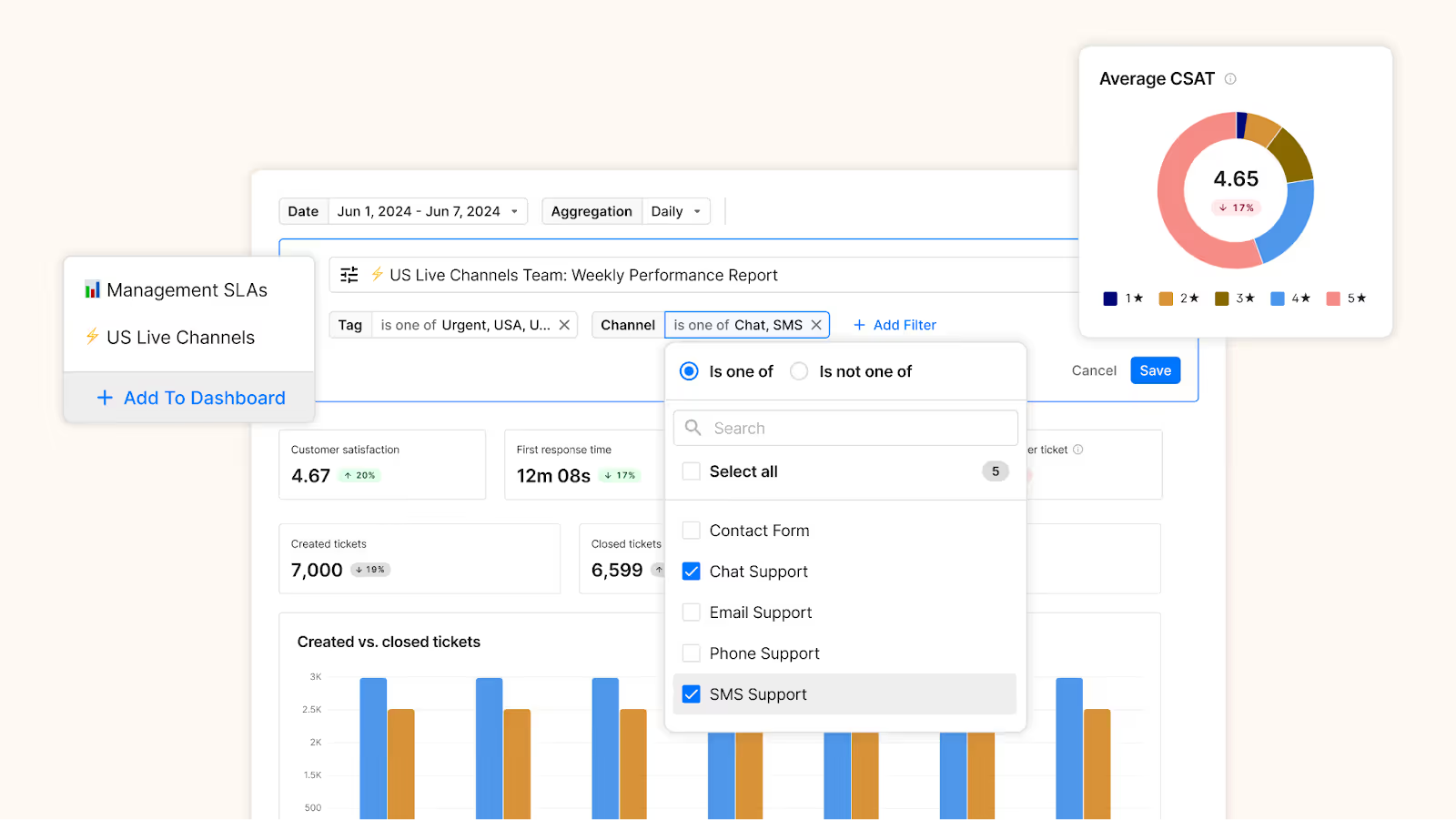
Effortless, in-house migration for new joiners
Leave the moving to us—we now manage migrations in-house. Depending on your plan, our Implementation team will transfer emails, customers, macros, and more for you. Combined with 99.99% uptime, switching platforms is smoother, faster, and more reliable than ever.
For accelerated performance, consider our 50-in-50 implementation program, which aims to resolve 50% of your ticket volume using AI Agent within 50 days.
Enterprise customers receive a dedicated Enterprise CSM, optimization workshops, and 24/7 support to get the most out of Gorgias from day one.
What’s coming next
Our teams are hard at work changing the landscape of customer experience. Here’s what’s on the Gorgias Product Roadmap:
- Cleaner, minimal interface. We’re giving our UI a new look to reduce clutter and highlight key information, making conversations front and center.
- Detailed order view. Quickly view past purchases and make order updates without opening new tabs or interrupting your workflow.
- Shop right in chat. Soon, product photos, descriptions, and even customer reviews will be shown directly in Gorgias Chat, so shopping experiences are as frictionless as possible.
- Scheduled CSV exports. Prove the value of CX with automated exports, perfect for stakeholders, whether they use Gorgias or not.
- New integration with Assembled Workforce Management. Our partnership will help you leverage Gorgias ticket data to optimize forecasting and agent scheduling.
- Role-based access control. Decide which dashboards, views, conversations, and settings can be accessed by each user role.
- Okta single sign-on. Let your team sign in to Gorgias using the same authentication service you use for the rest of your tech stack.
The future of support starts with your helpdesk
Our latest helpdesk updates make it easier than before to create memorable customer moments.
As Bora Shehu, our VP of Product Design, said, “We hope that the tools we’re building help you spend less time on robotic work, and more time on impactful human work that grows your businesses through the power of conversations.”
If you’re not on Gorgias yet and want to see what’s possible, book a demo today.
{{lead-magnet-1}}
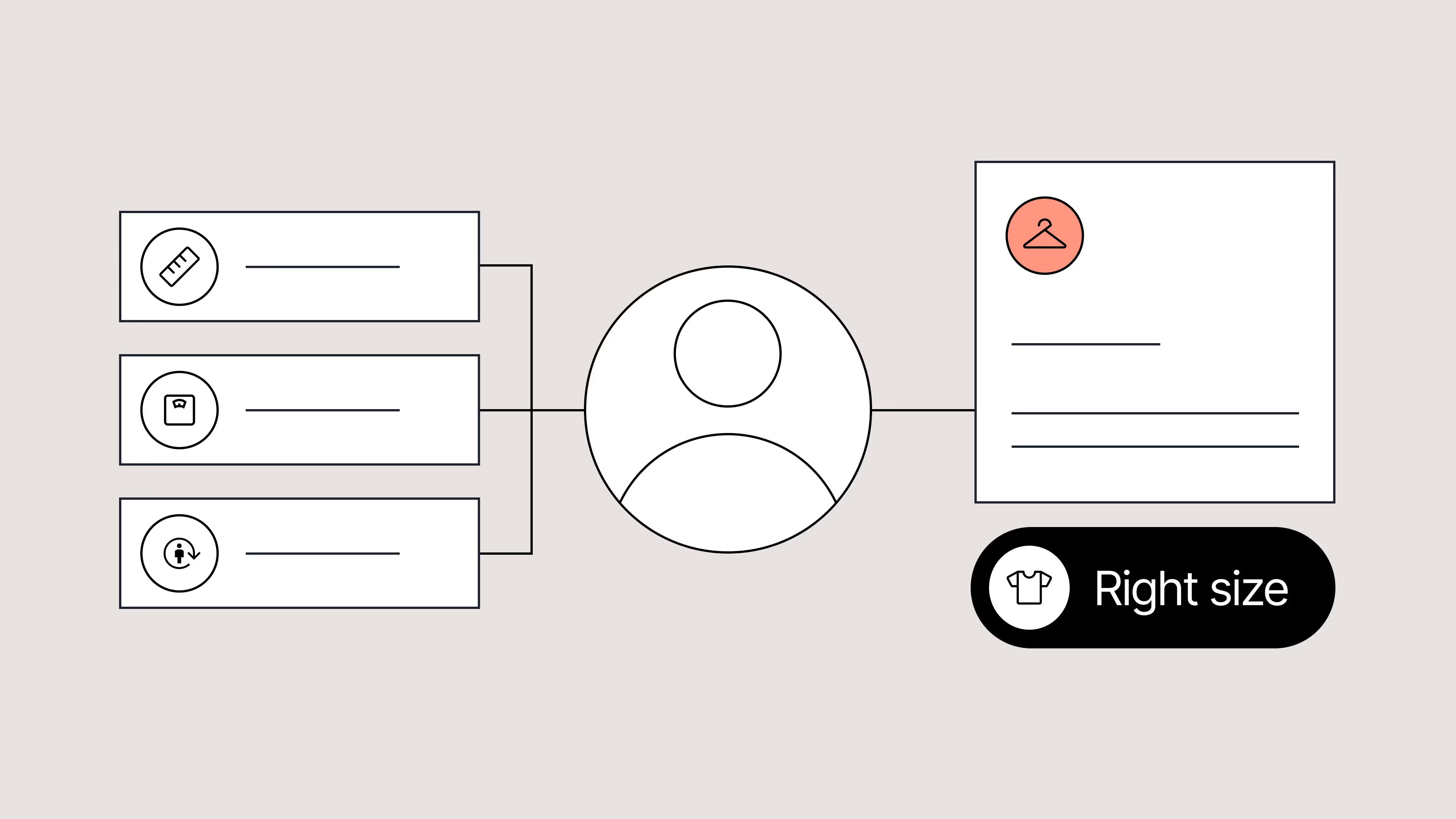
How Online Sizing Solutions Are Replacing the Fitting Room
TL;DR:
- 58% of fashion shoppers “bracket” orders—buying multiple sizes and returning what doesn’t fit. This drives high return rates, increased costs, and customer frustration.
- 70% of returns are due to sizing issues. Nearly half of shoppers abandon carts over inconvenient returns.
- Leading solutions include: AI-powered fit tools, 3D visualizations that show scale and model stats, “fit finder” tools, at-home fitting experiences, and AI-powered customer support.
- Brands that replicate the fitting room online gain higher retention, lower costs, and stronger sustainability.
Sizing has long been a friction point for ecommerce fashion shoppers.
Without the ability to try items on, 58% of shoppers resort to "bracketing"—ordering multiple sizes of the same piece and returning what doesn’t fit.
While it gives customers a temporary fix, it ultimately creates frustration for them and logistical headaches for brands.
The result is rising return rates, higher costs, and wasted resources. To break this cycle, ecommerce brands need to rethink how they guide shoppers toward the perfect fit. The good news is that many brands are already showing the way by using AI-powered tools and smarter product experiences to replicate the fitting room from the comfort of home.
{{lead-magnet-1}}
Returns are getting unsustainable
Recent data highlights just how severe the return challenge has become for fashion and apparel retailers:
- 46% of shoppers have abandoned a purchase because return methods were inconvenient.
- Fashion and apparel brands get twice as many return requests than any other industry.
- According to Gorgias data, 70% of returns are due to sizing confusion.
- “Will this fit me?” is one of the top reasons customers contact support.
In addition, rapidly rising concerns around sustainability and climate change, as well as heightened awareness around over-consumption, are prompting consumers to make changes in their purchasing habits.
Brands who prioritize well-fitting, long-lasting pieces and reduce carbon footprints and the amount of clothing diverted to landfills by lowering returns can actually benefit from a strategic edge.
“Those who choose to approach sustainability with a long-term mindset even while battling short-term problems will be rewarded with more efficient business operations and a competitive advantage,” writes McKinsey in its State of Fashion 2025 report.
Effective sizing solutions for ecommerce brands
Most brands already have size charts, but shoppers don’t want to measure themselves, or find those charts to be inaccurate.
When shoppers lack confidence in choosing the right fit, they either abandon their carts or rely on bracketing, both of which lower profitability and customer trust.
Forward-looking fashion and apparel brands are solving sizing issues by using tools for a more intuitive shopping experience. This ultimately helps them build loyalty, increase retention, and reduce returns.
Implement AI-powered body measurement tools
Rather than purely providing static size charts on your website, opt for AI-generated personalized fit recommendations instead.
For example, European fashion retailer Zalando reduced size-related returns by 10% using AI-driven advice.
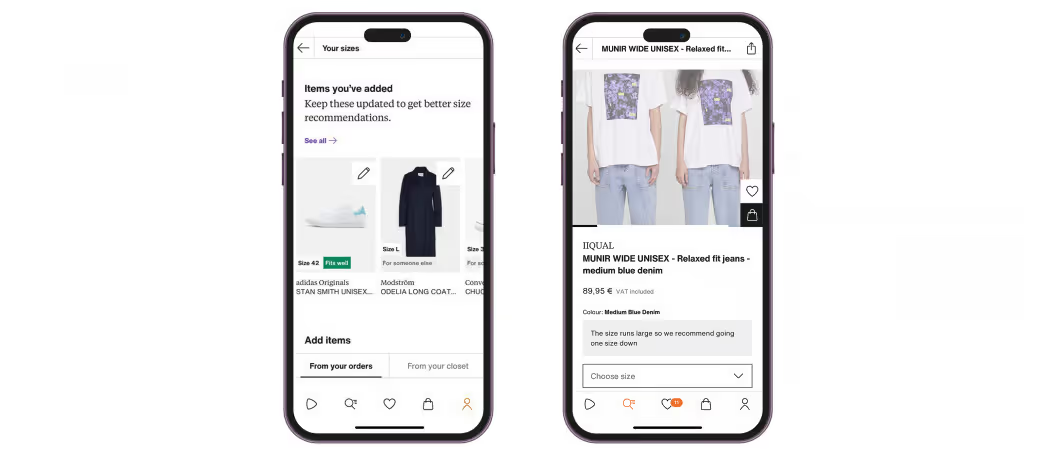
The brand flags whether an item is true to size or not. It also offers the ability for customers to see recommendations based on logged fit-based return reasons, past purchases, and other clothing items that fit them well.
Zalando also launched a body measurement feature in 2023 where shoppers can actually scan themselves for more accurate size advice.
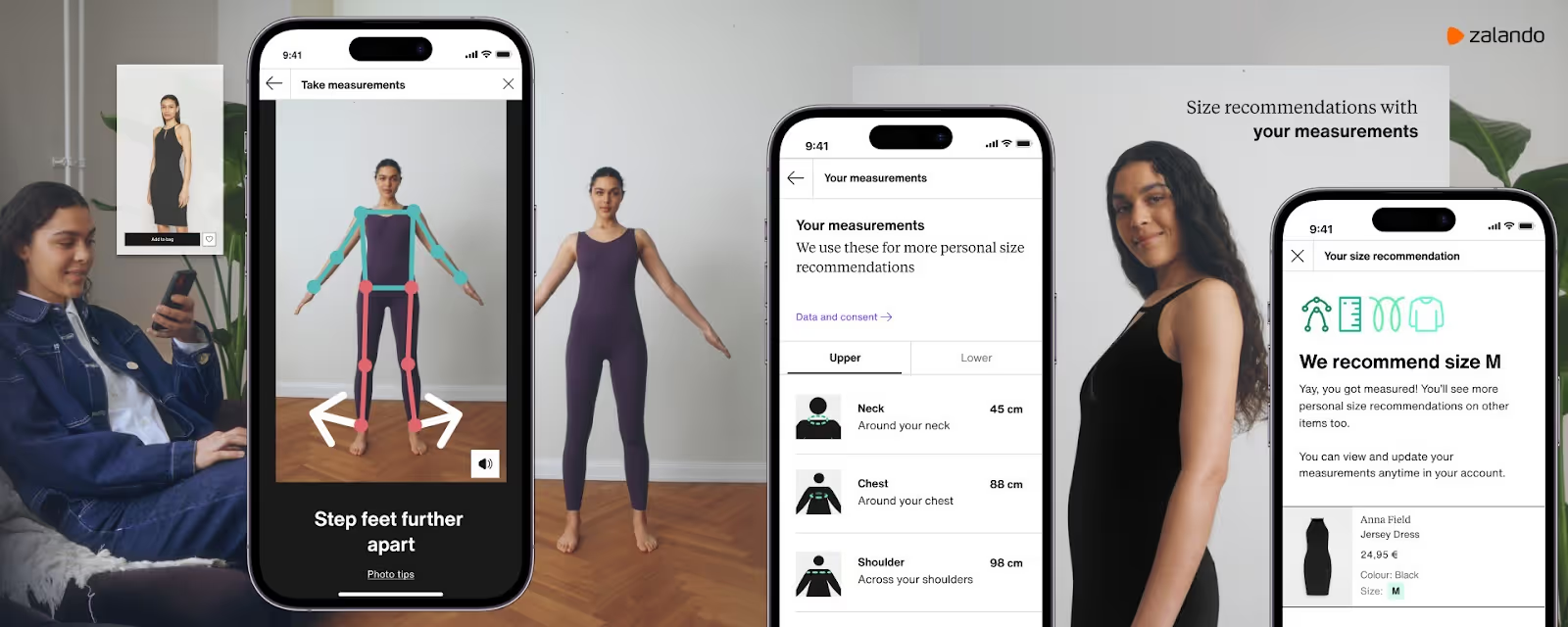
Show size and scale in product photos
As AI grows in proficiency, there are more tools than ever to help shoppers visualize product scale and fit.
For example, accessory shop LeSportsac uses Tangiblee, a product experience tool, to help customers understand scale and what fits inside each bag.

Performance hunting gear shop KUIU takes another approach. It uses a photo-based layering guide, so shoppers can see how the size and fit look with multiple layers on a model. Different model stats shown within product photography give contextual sizing cues.

Sleep shop Cozy Earth takes a similar route, stating model height and size on product photos.
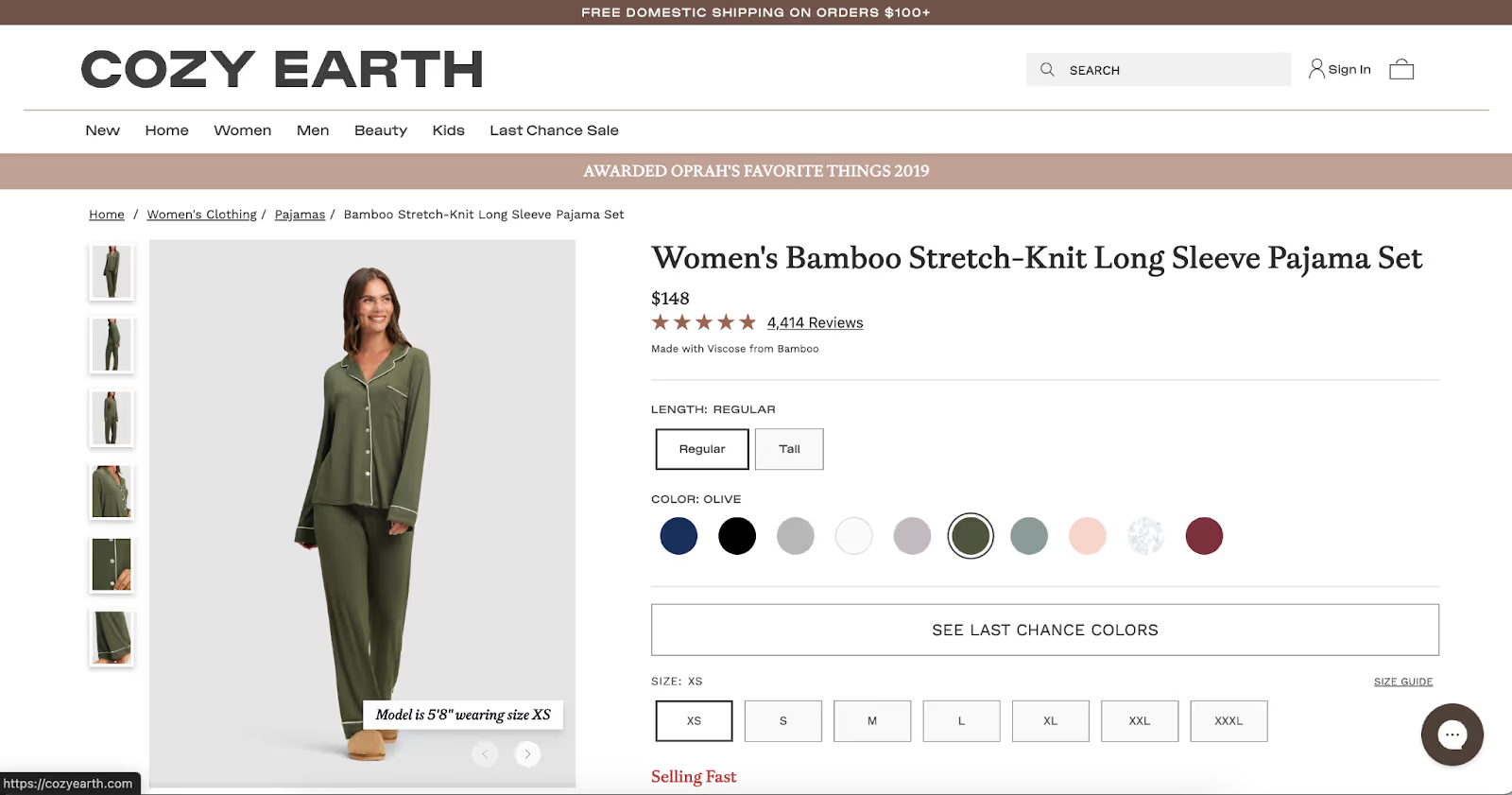
Introduce “fit finder” tools
Some brands are helping shoppers pick the right size with interactive quizzes based on factors like height, weight, and the sizes of other clothing items that fit well. SuitShop is among those brands using a Fit Finder quiz on its website.

Similarly, Psycho Bunny leverages the AI tool True Fit as a size finder on product pages.
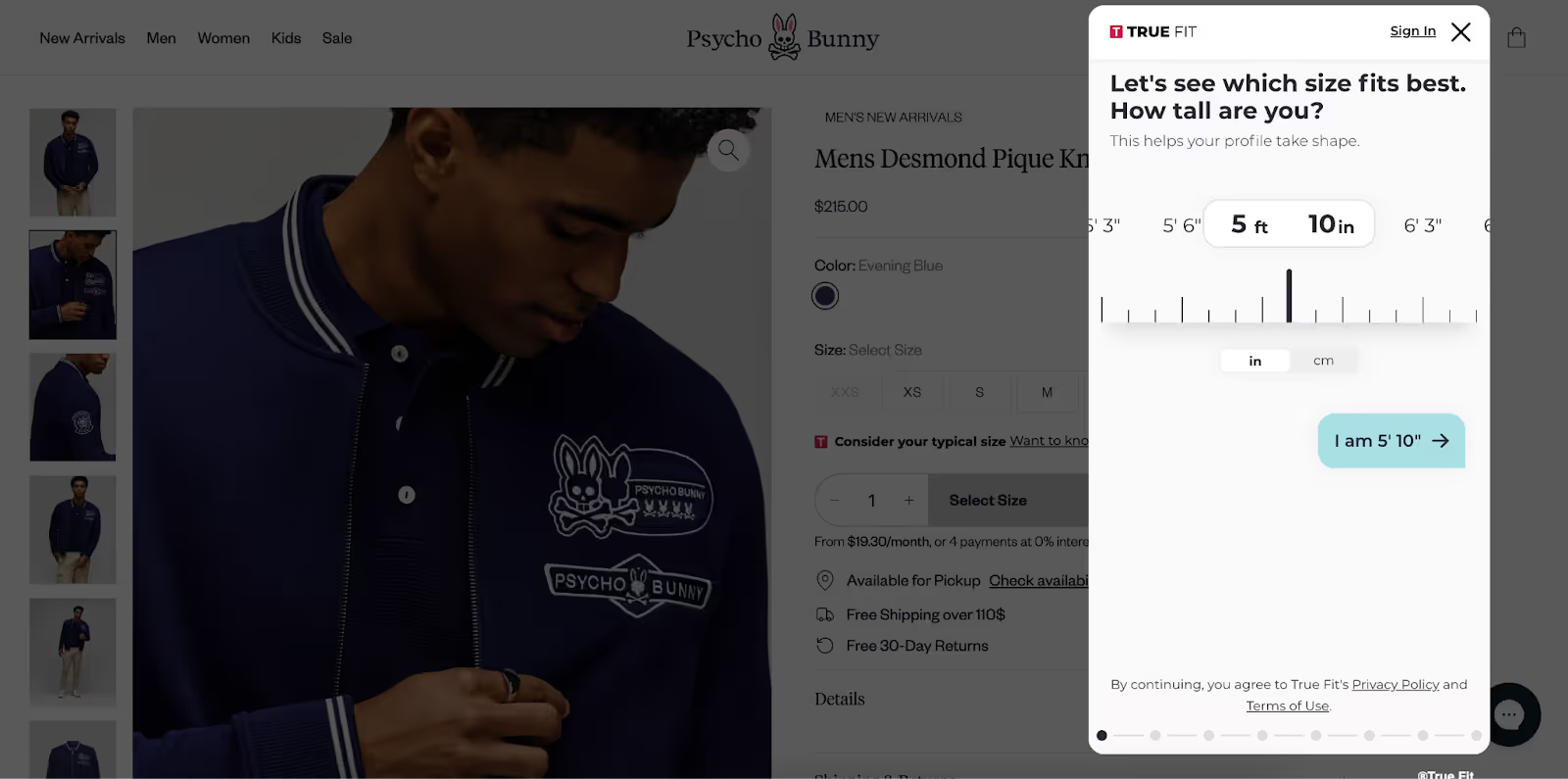
Bring the fitting room home
Ergonomic shoe brand Orthofeet eliminates sizing qualms altogether by including customizable inserts inside each box. Fitting spacers ensure a snug fit and arch enhancement for those who need it, helping shoppers get comfortable shoes that fit.

Jonas Paul Eyewear shares the “try it on at home” approach, offering a free or low-cost home try-on kit.

Leverage AI-powered customer support
Gorgias Shopping Assistant helps brands meet that need by delivering human-like guidance at scale, giving shoppers instant answers that feel personal.
For example, VESSEL uses Shopping Assistant in chat to provide real-time support on sizing and inventory, helping customers choose with confidence. By addressing fit questions directly, Shopping Assistant reduces returns and builds trust at the point of purchase.

Similarly, outdoor clothing retailer Arc‘teryx provides an “ask me anything” AI chat where shoppers can confirm any questions they have around fit or sizing.
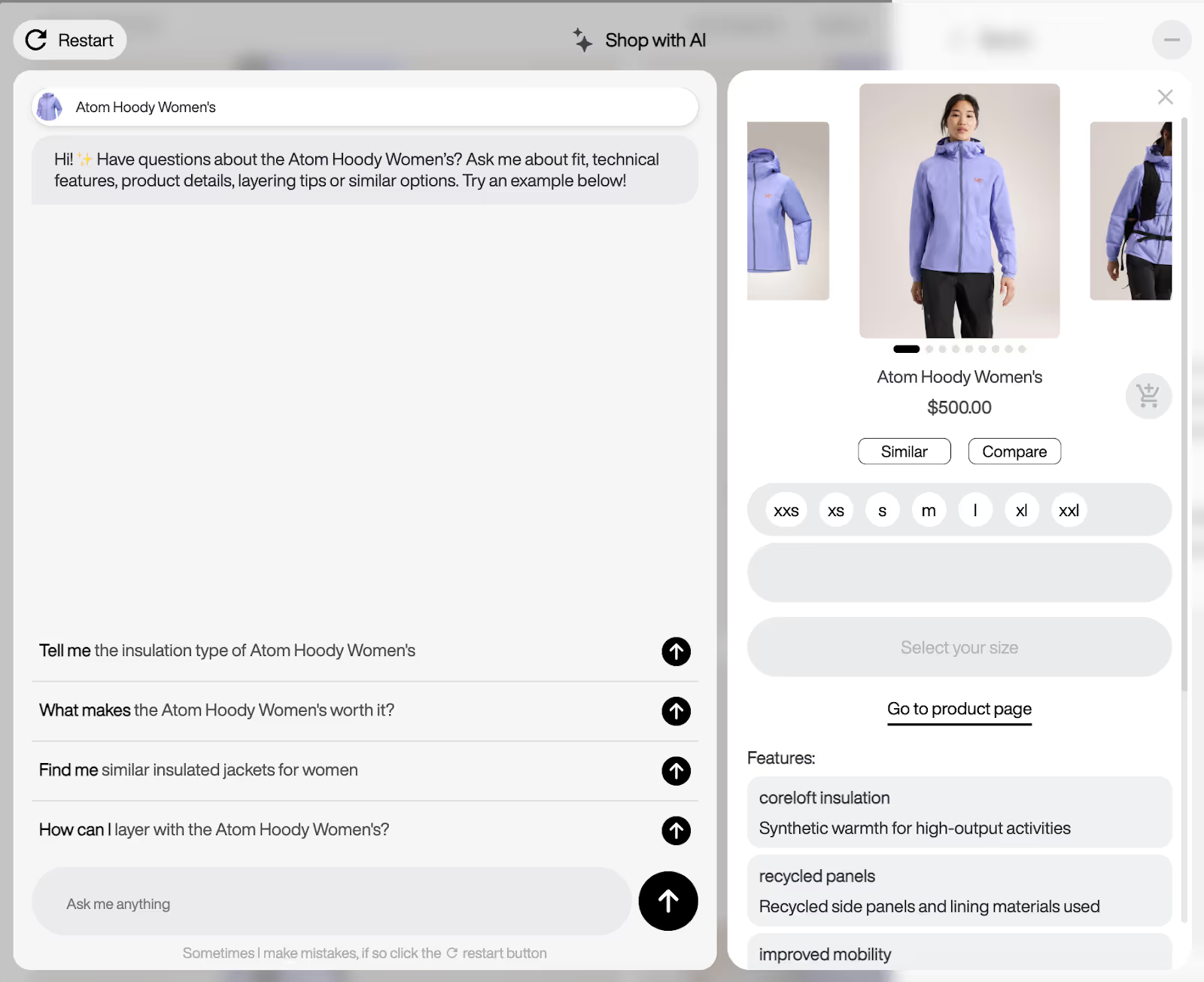
The future for ecommerce size guides
Sizing for ecommerce fashion and apparel brands has become a business-critical challenge. With 70% of returns tied to fit issues and nearly half of shoppers abandoning purchases over inconvenient returns, brands that replicate the fitting room online stand to gain a competitive advantage.
From Zalando’s 10% reduction in size-related returns to VESSEL’s use of AI-powered chat, the path is clear: investing in smarter size chart solutions pays off with higher retention, lower costs, and stronger sustainability.
The brands that provide fitting room-level experiences online now will set themselves apart from the rest.
Book a demo to see how Gorgias, the leading conversational commerce platform, helps fashion brands cut returns, drive sales, and deliver fitting-room level experiences online.
{{lead-magnet-2}}
Further reading

Event #1: Optimizing Brand Experience To Drive Revenue
Last thursday, we organized our first event at Gorgias. It was the perfect opportunity to celebrate our new round of funding and recent moving to a new office in SOMA, while discussing brand culture and customer experience.
Special thanks to our speakers Renee L. Halvorsen from Marine Layer, Alicia Levine from Sunski, Dorian Greenow from Keto-Mojo and Anthony Benedettini from Dry Farm Wines.
 |
Here are the key takeaways you should remember:
- As an e-commerce brand, you cannot compete on price with Amazon and powerful dropshippers. That’s why brand experience is your key differentiation factor.
- Building a strong brand experience requires to be present on each distribution channel. Don’t let your resellers do the job for you! Sunski for example prepares “environment kits” for their resellers and marketplaces. This way, customers can experience Sunski’s spirit beyond its website.
- When building brand experience, your community is your key success factor. Create a pool of ambassadors who will promote your brand, and reward them with presents, promo codes, and dedicated attention.
- Bet on your own team! Building a great mindset within your team will help you create a strong and consistent brand image. At Keto-Mojo, each member of the team does customer service, so that everyone focus on what customers really need. Besides, the founder should inspire a culture of passion and dedication to the product.
You missed our event? Don’t worry, it was the very first of many!
Curious about how Gorgias can optimize customer service? Create an account here and get started in a few minutes!

Thank you, interns!
At Gorgias we've been very fortunate to work with some amazing people who did their internship with us:
Amit Poonia
Astrid Parmentier
Emilie Drouin
Hadrien de Lamotte
Ram Goli
Thank you all for your work!
Their contributions big and small make an indispensable part of what Gorgias is today and what it will be in the future. We are very grateful for their hard work, and we want to continue working with them after they finish their studies. To make returning more attractive for them, we've decided to take into account their stock option vesting period if they ever decide to return as full-time employees.
What exactly does this mean?
Interns that decide to return to Gorgias within a limited amount of time and choose to take our stock options offer upon the start of their full-time employment will have an accelerated schedule of their stock option vesting period. The offer will be judged case by case with our board's approval.
Let's take the example from our friends at Cockroach Labs (which this decision was inspired from):
For example, our standard option vesting schedule is that 25% of the stock options vests after 12 months of service from an employee’s start date (the “cliff”), and the remaining option vests in equal installments over the following 36 months of continuous service. However, if an intern spent four months with us, on their hire date, they would only have eight months until they hit their one-year cliff date and vest 25%.
We hope that by doing so, we're showing that we're taking their time seriously and we show our intention to work with them beyond their internship.

Announcing the ReCharge integration
Recharge is the most popular subscription app in the Shopify app store and is the preferred solution for Shopify Plus stores. Over 10,000 Shopify merchants chose ReCharge to help sell products on a recurring basis, including stores like Dr. Axe, Hubble Contacts, and 5 Hour Energy.
The challenge is, when a customer has an issue with their subscription, the support team needs to jump between their helpdesk, Shopify and the ReCharge platform to fix the problem. This negatively impacts response time. Agents end up wasting hours per week going to ReCharge to skip a box for a customer, edit a subscription, etc. One of the key advantages of using Gorgias is to manage all your customer support in one place. A few months ago, our customer Darn Good Yarn asked us to build an integration with ReCharge. They no longer wanted to switch between ReCharge, Shopify and their helpdesk. This was completely aligned with our vision, so we decided to build it.
Today, we're excited to announce we've partnered with ReCharge to launch this integration.
Here are the key benefits:
- Display ReCharge subscriptions next to support tickets.
- Edit ReCharge subscriptions in one click from your helpdesk: refund charges, skip monthly payments or cancel subscriptions from Gorgias
- When a customer ask to edit their subscription, you can send them an auto-response with the link to manage the subscription.
“Gorgias gives us a holistic view of our customers. This way we can provide them with fast and personalized help”
Nicole Snow, DarnGoodYarn
Let’s take the example of Averill John. She wants to cancel her subscription to the Yummy Box and has just sent an email to your support.
Here is how your helpdesk looks like:

You can see that Astrid has been assigned to this ticket and that this ticket is tagged “Ambassador”. It means that Averill is one of your super loyal customers.
On the right, you can see the ReCharge account data of Averill. Here, Averill has a monthly subscription to the Yummy Box and will be charged on the 15th of October.
Astrid can skip the October charge in one-click on the “Skip charge on subscription” button. It will immediately set the action within ReCharge. Response time? Less than 1 minute!
If you're already a Gorgias customer, head to your account and go to Integrations to connect ReCharge. If not, you can create an account here and get started in a few minutes.

Announcing the Aircall integration
One of the key advantages of using Gorgias is to provide a unified support experience to your customers across all channels. A few months ago, some of our customers asked us to build a phone integration. Traditional helpdesk integrations simply log calls as tickets. We wanted to go one step further and associate the phone call with the right customer.
Today, we're excited to announce we've partnered with Aircall to build this integration.
Aircall arms small-to-medium sized business (SMBs) with a phone system built for modern business. With zero hardware to manage, dozens of integration options to explore, and the ability to add local numbers in more than 40 countries, support teams can easily provide phone support in minutes.

Here are the benefits of this new integration:
- When a customer calls your company in Aircall, it creates a ticket in Gorgias and automatically matches it with the corresponding Shopify customer. This way, your staff can edit orders while they are on the phone with the customer.
- Your team sees all previous interactions they had with each customer, under their timeline.
- Get omni-channel statistics. Gorgias stats include Aircall phone data. For instance, you can monitor if you're getting more return requests over the phone or through Facebook Messenger.
If you're already a Gorgias customer, head to your account and go to Integrations to connect Aircall. If not, you can create an account here and get started in a few minutes.

We're joining the Shopify Plus Technology Partner Program
Today, we’re thrilled to announce we’re joining the Shopify Plus Technology partner program.
Over the past few months, we’ve worked with some incredible Shopify Plus merchants like Darn Good Yarn, Fjallraven and Frichti, who serve tens of thousands of customers every month. What they all had in common was a shared commitment to maximizing the efficiency of the customer service team to keep delivering high-quality support as they grow.
We’ve worked with other technology partners, like LoyaltyLion, in order to provide merchants with a holistic view of their customers when they respond to them in an effort to continue delivering best-in-class support interactions. We’ve also worked with the Plus team to leverage the latest features of the Shopify Plus API, to allow agents to create customized solutions for their customers, For example, creating personalized gift cards based on support conversations. Also, check out the guide we wrote comparing Shopify and Shopify Plus for an idea of the additional functionality and benefits ecommerce business owners get when they upgrade to Shopify Plus.
Using our technology, we’re proud to announce that our Shopify Plus customers have managed to improve their support request treatment time by 30%.
By joining the Technology Partner Program, we’re excited to take our collaboration with Shopify Plus and Shopify Plus merchants to the next level, by further enabling more customers to improve their customer service.
"We are glad to welcome Gorgias to the Shopify Plus Technology Partner Program. We’re particularly excited about how they’re helping our merchants provide efficient & personalized customer support, and hope they can help more of them."
Jamie Sutton, Head of Technology Partnerships, Shopify Plus

We're integrating with LoyaltyLion!
Great news! Today, we're announcing a new integration with LoyaltyLion. LoyaltyLion is a digital loyalty framework that gives ecommerce stores innovative ways to engage and retain customers.
Our mutual customer Darn Good Yarn uses it to successfully increase customer retention. When they switched from Freshdesk to Gorgias to manage customer support, they wanted to leverage their loyalty program for customer support.
We used their feedback to build the integration with LoyaltyLion, which they have been using for a couple months in beta. Today, we're excited to make it available to all our users.
What is the LoyaltyLion integration?
Here are some of the benefits of this integration:
- Display how many points a customer has when they contact your support team
- When you respond to customer support requests, award loyalty points to customers directly in Gorgias
- Include the customer's personal referral url in your responses. This way, if they are happy about your support, they'll refer their friends to your store.

Overall, this allows your team to use your loyalty program for customer service.
"We love being able to issue our customers loyalty points directly from Gorgias! It's a great way to boost efficiency and also customer retention."
Chloe Kesler, Customer Support manager at Darn Good Yarn
How can I use the LoyaltyLion Integration?
The integration is immediately available on your Gorgias account. If you don't have an account, you can create one here. Then, follow the instructions in our documentation and you can get started!
.avif)
How to leverage customer support to increase sales?
Most customers are loyal to brands because they know what level of service they can expect. As a result, providing an above-average customer experience is key to increase repeat in sales.
It’s relatively easy to provide great support when you get started with your store: your team gets a few dozens of support requests a day, and they respond to them almost instantly. The thing is, this level of service is very hard to maintain as you scale. Response time usually drops, and most brands start using standardized macros to keep up with the pace, which is a poor customer experience.
Your sales have increased, good. Now, you need to get your customer support up to speed

Source: Gorgias customers during the Thanksgiving peak
At Gorgias, we’ve been chatting with 400 stores over the past year, and we’ve seen a lot of them working on crossing this “chasm”.
This post shares learning on how you can build a customer support organization that will scale with your business, and provide best-in-class customer service, which will drive customer retention.
Step 1: Run an audit of your support organization
A good place to start is to list the most common reasons customers are contacting you about. Go ahead and manually classify 200 tickets from your support inbox. This should take you about an hour. You can build categories from scratch, or use this spreadsheet of the most common requests for e-commerce companies we built.

Now, you should be able to understand what problems are causing the most pain to customers.
If a specific type of request is above 10% of requests, then it’s a good candidate for optimization. For instance, if you’re getting a lot of “where is my order” questions, here are a few things you can do to deflect those:
- Add a tracking section for customers to track their package on your site. Aftership can help here.
- Send updates to customers about issues with delivery, through SMS or email.
Now that you have a good understanding of the reasons customers are contacting you for, you can map the customer journey, and identify what actions your agents need to take to respond to tickets.
Later, you can use this for training purposes, and to identify optimization opportunities.
At Piper, we basically studied the whole customer journey and tried to identify all reasons why someone could contact us (based on previous history). This helped us quickly identify where customers were "blocked"
Finally, let’s analyze the efficiency of your team. Of course, every business is different, but you can use this table to figure out how efficient your agents are compared to other stores. A good metric to track it is ticket closed per month. Just make sure that satisfaction remains consistent.

Related: Learn more about the impact of live chat on sales. And see how Gorgias live chat can help you turn more browsers into buyers with chat campaigns.
Step 2: Figure out how you can improve the customer experience
Now, let’s work on creating “wow moments” for your customers. If you manage to exceed customers expectations when they contact you, you’re most likely to increase their loyalty and have them refer your store to their friends.
Here are a few ways you can create “wow moments”.
Make it easy for customers to contact you
You should be where your customers are. For example, if you have a Facebook page with a large audience, consider it as a real customer support channel. The point is, you should provide the same level of assistance across all support channels that your customer will use.
Also, don't be afraid to contact customers first, especially when they have items in their shopping cart. Offering help or a discount code at the right time could make the difference between a sale and an abandoned cart.
Example: providing high quality support on Facebook
70% of customers consider Facebook as a live chat support. To maximize customer satisfaction, your response time should be no more than 1 min. You’ll then be listed as a very responsive page, which will encourage your customers to respond.

You can also leverage public posts to build relationship with your customers. Another easy way to facilitate customer communication is to remove the need for customers to repeat themselves. On your support platform, make sure your merge Facebook conversations with email tickets. This way, if the customer switches channel, your team will have access to the context of what the customer said before.
Related: Check out our trends and best practices for customer support.
Personalize every interaction with customer support
You should leverage every data point you have about the customer to personalize the way you communicate with them:
For how long they have been a customer
Their order preference
Their location
The days of the “we value your business” are over.
Always go an extra mile for your customers. If the customer asks for the status of their order, don’t respond only with the tracking number. Go get the order status on UPS so the customer doesn’t have to do it themselves when they’ll receive your email in the subway with poor network connection.

Another good thing to do is to use a specific tone with your customer, that matches the brand image you want to convey.
If you’re into gifs, you can use them to build a brand tone your own set of gifs, designed for your own brand, and use them in your support emails. You can hire an illustrator on Upwork for that, or build them yourself.
Related: Tips to respond to angry customer emails.
Step 3: Give your team the “ironman suit” for support
Now that you know the level of support you aim at giving your customers, and you know what actions your agents need to take to get the delivery info, create an RMAs, etc., you can start optimizing the process for them.
Display rich customer profiles for your agents
To personalize messages, your agents need to have access to customer data. You can leverage the standard Shopify integration from your help desk as a starting point.
Though, it can be relevant to connect other data points to your help desk:
- Display fulfillment data. Shippo is great for that
- Inventory data: Stitch, display inventory to the reps
- NPS responses
- Responses to last promotions
If you’re on Zendesk, enabling the Shopify integration is a good start: it shows how much the customer has spent, and the past orders.
Some Gorgias customers have pretty advanced widgets that display data from Shopify, Stitch & Shipstation. This way, all the customer information is available.
Empower your reps to perform actions from support conversations
You can create custom widgets for your help desk, so that your agents can trigger actions from your help desk. Here are the most helpful actions:
- Create a coupon
- Place a replacement order
- Cancelling an order
- Create an RMA
This is a bit more tricky to implement. You need to build a custom app with buttons that will trigger actions - there are some good tutorials for Zendesk, Freshdesk & Help Scout. At Gorgias, we’ve built integrations with Stitch, Shipstation to embed these actions in the product, and enable you to add your own.
Other 3rd party apps like Chargedesk enable you to refund customers in one click.

Step 4: Track your progress
Our goal here is to improve the customer experience to drive sales. A good way to track the efficiency of your support work is to compare the behavior of customers that have been in contact with customer support from those who have not.
Shopify helps you easily to this. You can create an integration between your help desk and Shopify to tag customers who reach out to support, using the Shopify API. Say you add a “customer_support” tag to them.

Then, you can use Shopify statistics to monitor how the cohort of customers who have been in touch with your support team behaves, and assess the impact of your efforts with customer support.

Another way to proceed is to tag orders that generated a support tickets. This way, if you work on improving delivery notifications, you can monitor the impact.
Final thoughts
Building a scalable support team that provides an amazing customer experience takes time.
Try to test different “wow moments”, iterate on the way you personalize messages, on the tone you’re using, and always track your progress. Among the teams we surveyed, several mentioned they managed to increase sales repeat by 30% after implementing these tactics.
Want to learn more about how customer support can improve your conversion rate and lead to more purchases? Check out our guides to ecommerce upselling and Shopify abandoned cart recovery.

Celery + Gorgias
Celery just released their API on Github, currently in beta. Here are some of the cool stuff you can do with it in Gorgias.
Display customer information
When you receive an email from a customer, you can connect your Celery account and see customer information (orders, shipping address, etc.). Here’s what it looks like:

To configure it, grab your Celery access_token, head to integrations, and add an HTTP integration using this URL:
https://api.trycelery.com/v2/orders?buyer.email={ticket.requester.email}
Then you can customize the sidebar to only show the Celery data you need to respond to customers. Click the cog and simply drag and drop elements you want to show.

Refunds, order change... without leaving tickets
Celery’s API enables you to perform a few actions from your favorite helpdesk:
- Edit an order
- Cancel an order
- Issue a refund
- Create a coupon
Here’s an example of how you can cancel an order from Gorgias itself. Say you already have a macro to cancel an order. Add an HTTP action to it, in this case:
https://api.trycelery.com/v2/orders/{ticket.requester.customer.data[0].number}/order_cancel
Then, when you use this macro and send it to the customer, it will automatically cancel the last order at the same time:

We hope this integration with Celery can save you time. If you'd like to try Celery with Gorgias, shoot us a note! At support@gorgias.com.

Building delightful customer interactions starts in your inbox



